Wooden walkways transform outdoor spaces with natural charm and functional beauty. These pathways offer countless design possibilities, from rustic garden trails to sophisticated elevated boardwalks. Each design serves as both a practical route and an aesthetic enhancement, creating inviting passages through landscapes. Modern wooden walkway ideas blend traditional craftsmanship with contemporary innovation, incorporating sustainable materials and creative patterns. Whether connecting different garden areas, spanning water features, or providing access across challenging terrain, these versatile structures adapt to various environments while maintaining their timeless appeal.
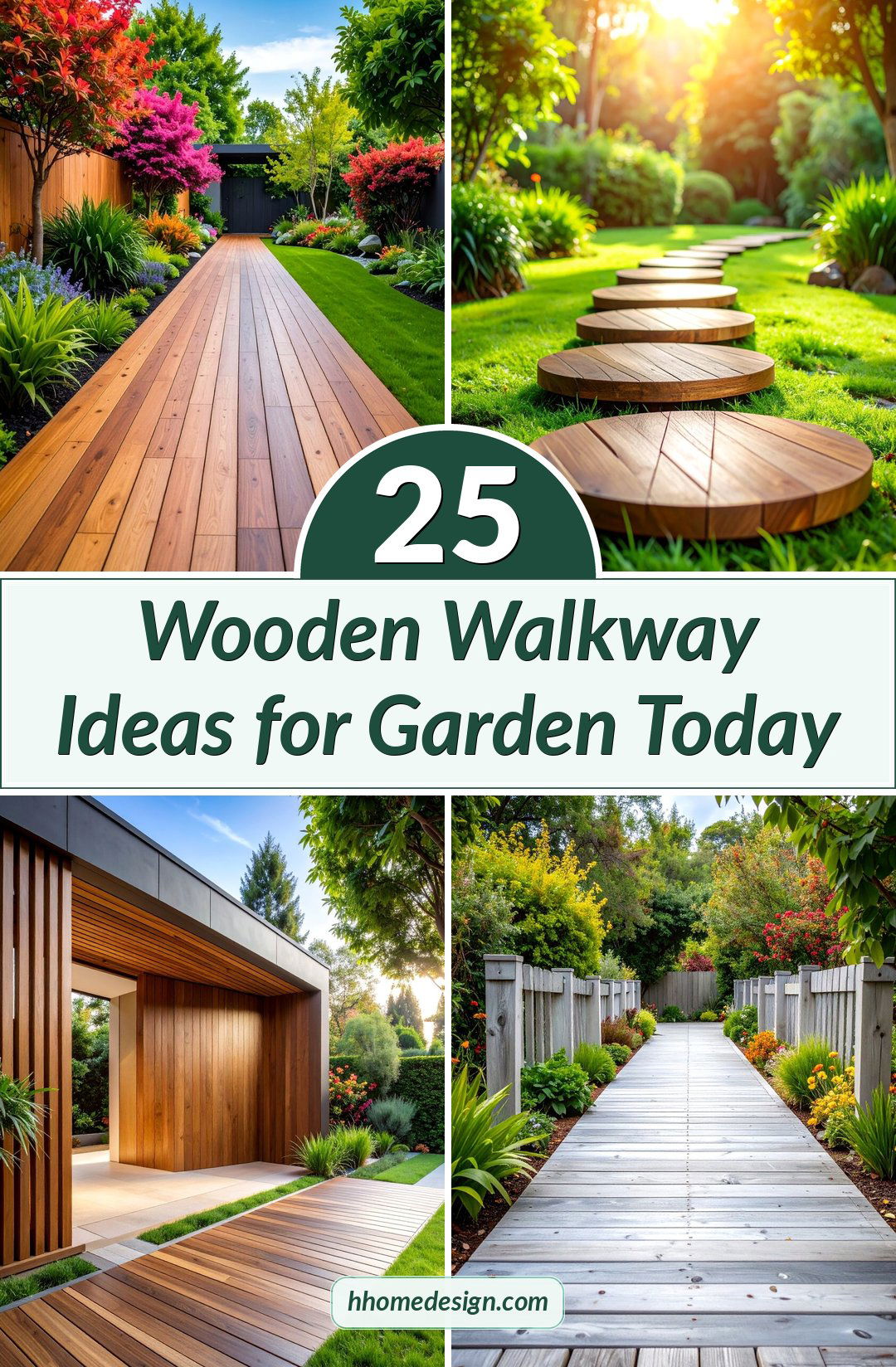
1. Floating Wooden Walkway Over Water Features

A floating wooden walkway creates magical visual effects by appearing to hover above ponds or water gardens. This design uses hidden steel supports anchored below grade, creating the illusion of a suspended pathway. Constructed with weather-resistant cedar or teak, the walkway maintains stability while embracing water's natural movement. The contrast between rigid geometric lines and flowing water below adds dramatic visual interest. Incorporate aquatic plants like water lilies around the structure to enhance the serene atmosphere. Strategic lighting underneath creates stunning reflections during evening hours, transforming the walkway into an enchanting garden focal point that invites contemplation and peaceful strolling.
2. Herringbone Patterned Wooden Boardwalk
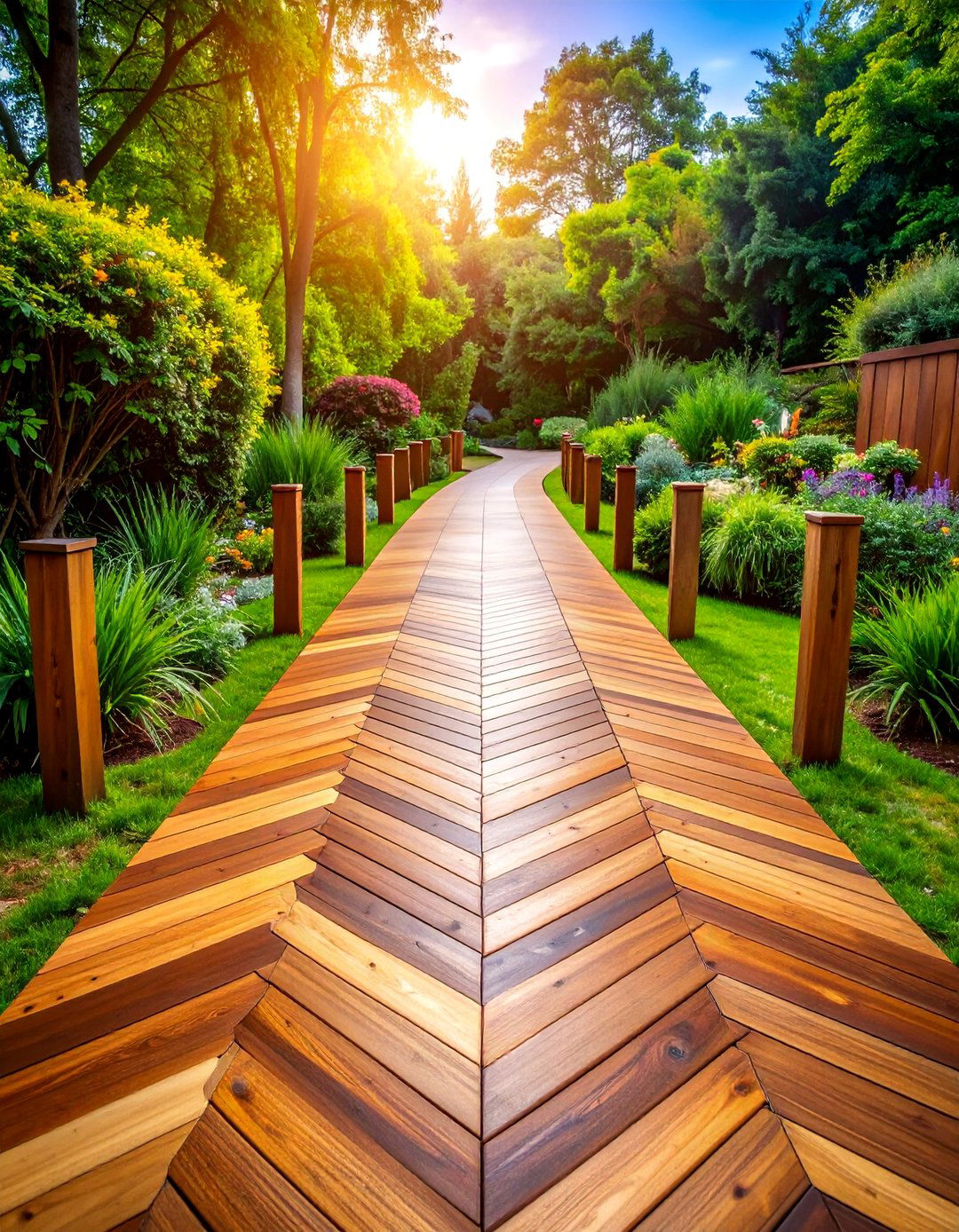
The herringbone pattern creates distinctive V-shaped designs that add sophisticated visual texture to wooden walkways. This classic arrangement involves laying rectangular wooden planks at alternating 45-degree angles, creating an interlocking zigzag effect. The pattern works exceptionally well for wider pathways, adding perceived width while drawing the eye forward toward destinations. Choose contrasting wood stains or different species to emphasize the geometric design. This technique requires precise cutting and careful alignment but results in a striking pathway reminiscent of European courtyards. The herringbone pattern also provides excellent structural integrity, distributing weight evenly across multiple contact points while creating an elegant, timeless aesthetic.
3. Spiral Wooden Garden Pathway
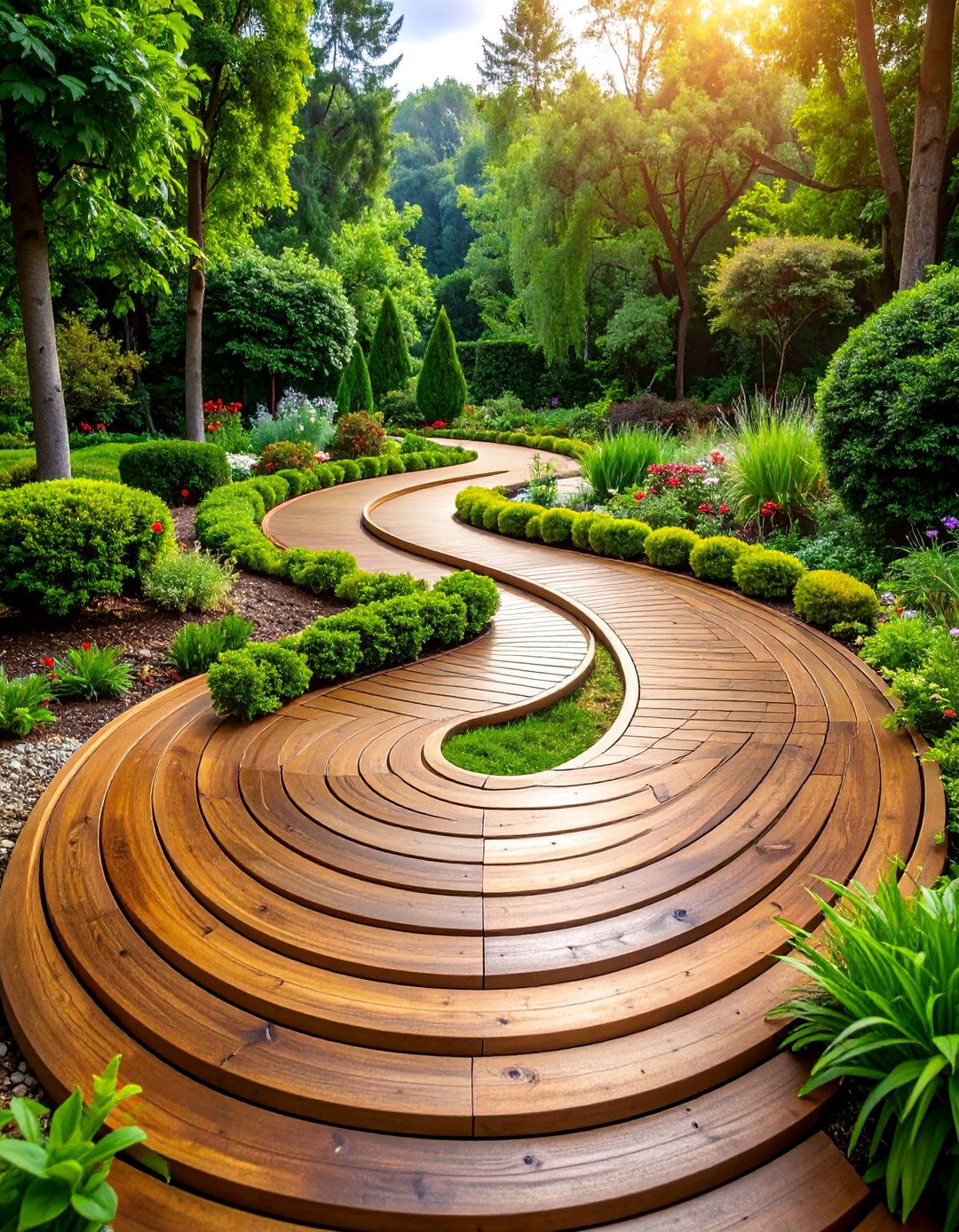
Spiral pathways add movement and visual intrigue while maximizing space utilization in compact gardens. This design creates gentle curves that guide visitors through different garden zones, encouraging slower movement and closer plant observation. Construct using curved cedar boards with consistent width, following marked arc patterns for smooth transitions. The spiral configuration works particularly well around central features like sculptures, fountains, or specimen trees. Plant aromatic herbs and flowering perennials along the edges to enhance the sensory experience. The curved nature softens hard landscaping elements while creating natural gathering spaces at wider sections. This organic approach transforms ordinary garden navigation into an engaging journey of discovery and contemplation.
4. Zigzag Japanese Yatsuhashi Walkway
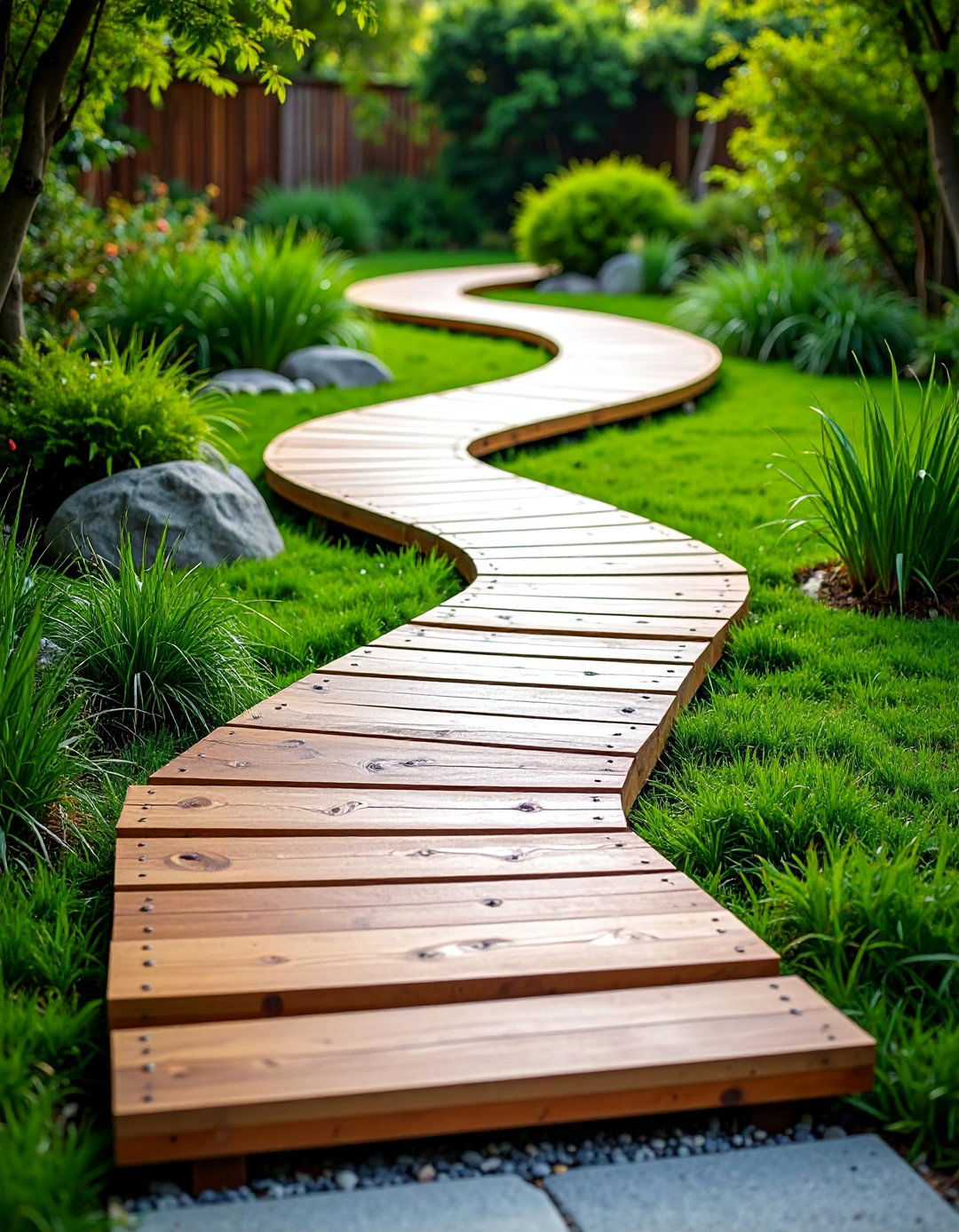
The traditional Japanese yatsuhashi pattern features eight wooden sections arranged in angular zigzag formation, historically believed to ward off evil spirits. This distinctive design creates contemplative movement through garden spaces, forcing visitors to pause and change direction at each angle. Construct individual platform sections connected at 90-degree turns, using weather-resistant hardwood for longevity. The angular pathway works beautifully over water features, through ornamental grass plantings, or across graveled areas. Each direction change reveals new garden vistas while creating natural stopping points for reflection. Modern adaptations can incorporate LED edge lighting or varied platform sizes while maintaining the essential geometric character that makes this ancient design timelessly compelling.
5. Elevated Multi-Level Deck Walkway
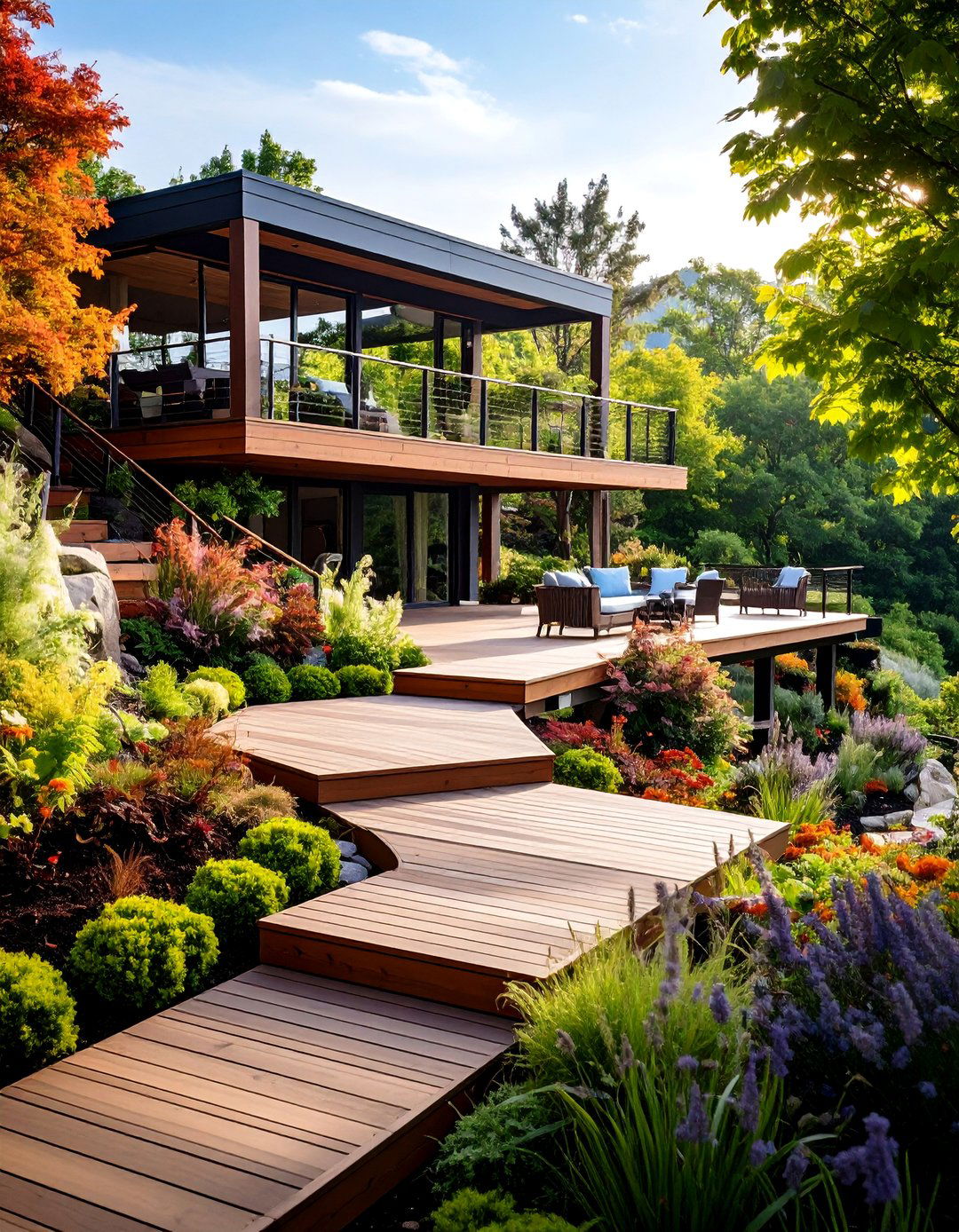
Multi-level deck walkways create engaging experiences by connecting different garden elevations through stepped platforms and landings. This design incorporates varying heights to accommodate sloped terrain while providing comfortable transitions between levels. Built with pressure-treated lumber framing and cedar decking, the structure includes integrated steps, railings, and occasional seating areas. Wide landings serve as observation points, allowing visitors to appreciate surrounding landscapes from different perspectives. The elevated design protects against moisture while creating space underneath for storage or additional planting. Incorporate built-in planters along railings to soften the structure's edges. This approach transforms challenging topography into an advantage, creating dynamic pathways that celebrate natural terrain variations.
6. Reclaimed Wood Rustic Trail
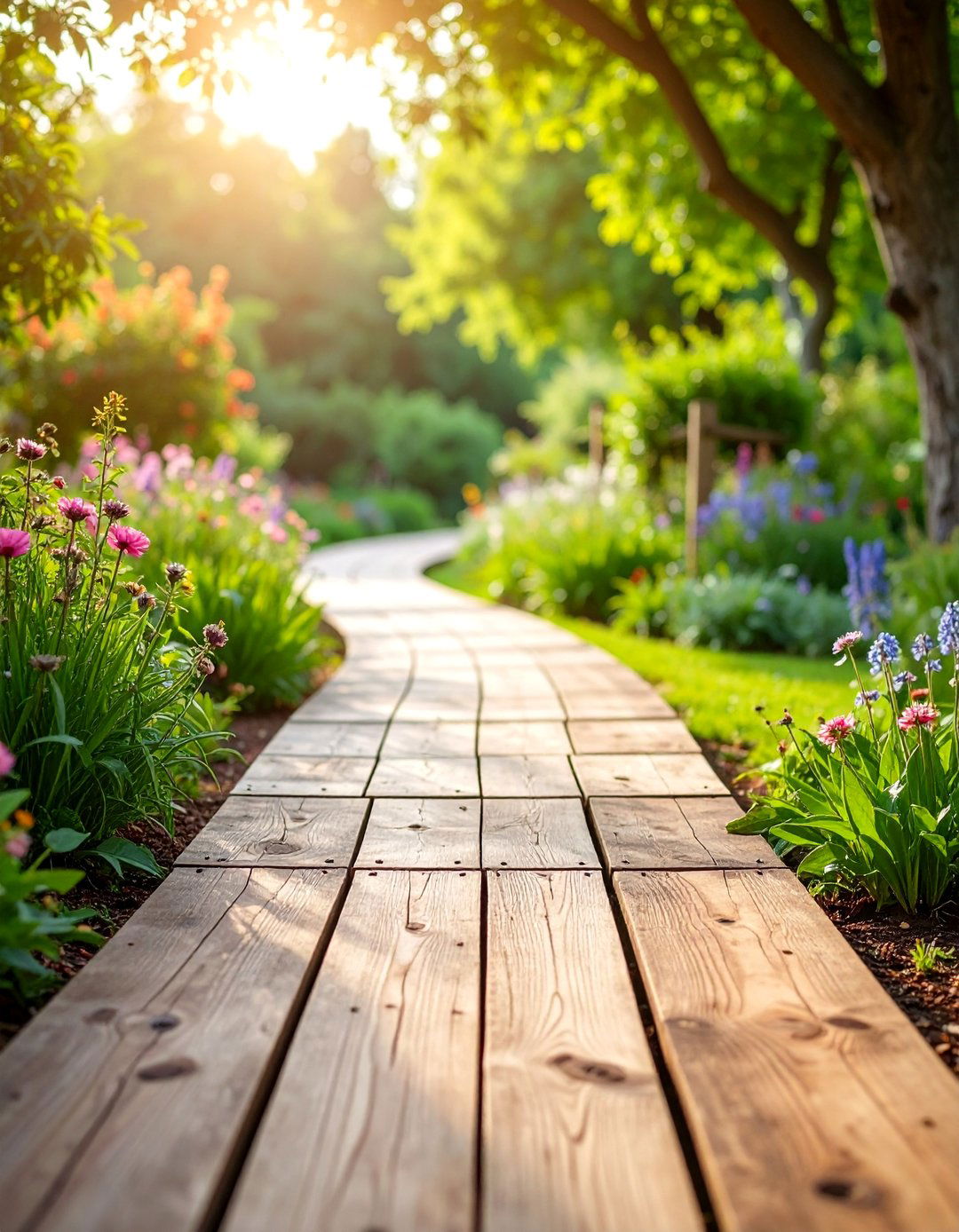
Reclaimed wood walkways offer sustainable beauty with distinctive weathered character and unique patina. This design celebrates imperfection, using salvaged barn wood, old decking, or industrial timber with existing nail holes and wear patterns. The irregular textures and varied wood tones create authentic rustic appeal that complements cottage gardens and naturalistic landscapes. Construct using a simple frame system that allows quick installation while supporting the reclaimed materials effectively. The weathered appearance blends seamlessly with informal garden settings, requiring minimal maintenance while developing additional character over time. Consider incorporating stenciled designs or vintage-inspired hardware to enhance the historical aesthetic. This approach demonstrates environmental responsibility while creating walkways with genuine personality and charm.
7. Modern Linear Wooden Slat Design
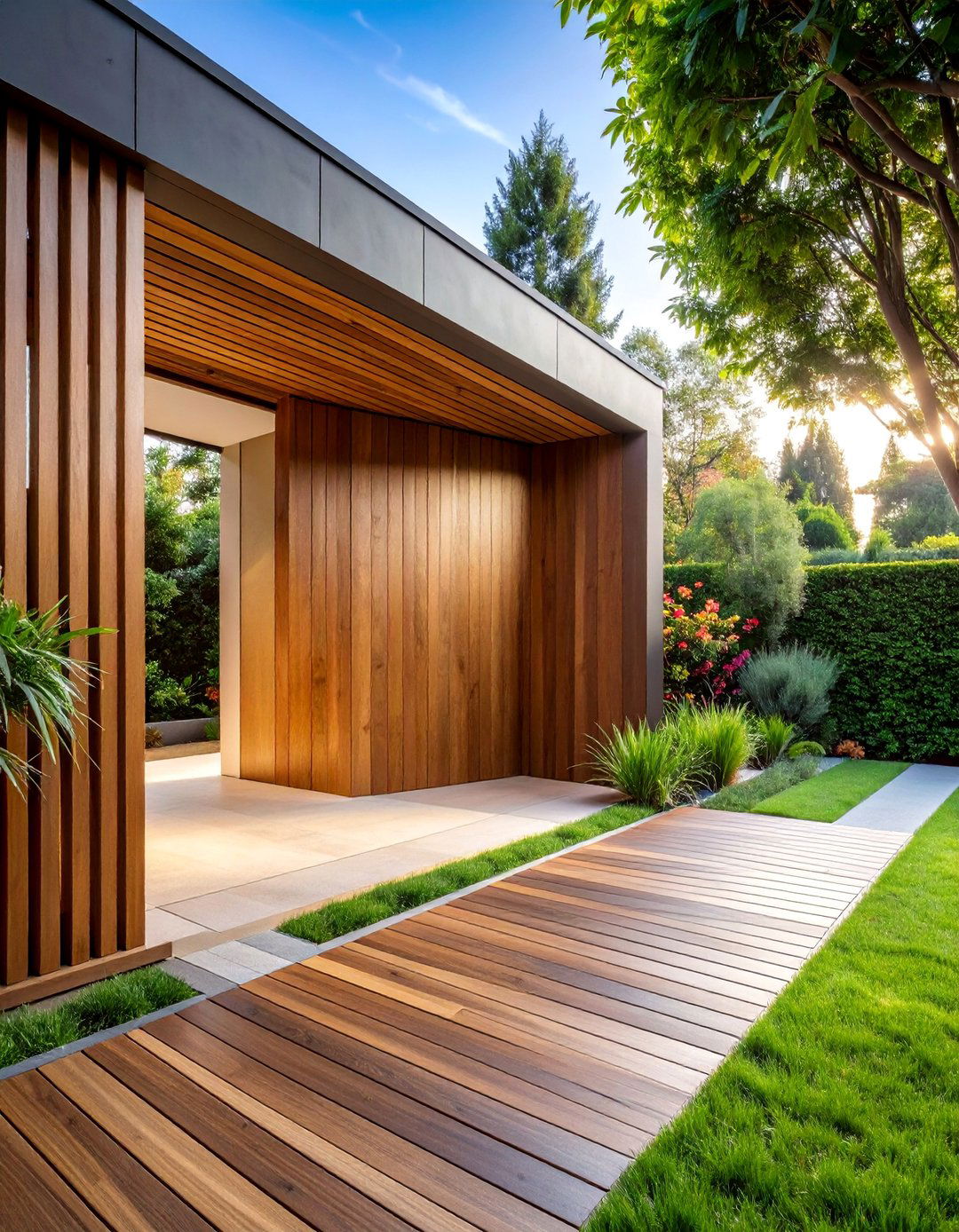
Contemporary slatted walkways feature clean geometric lines with alternating wood and grass strips for minimalist elegance. This design uses precisely spaced hardwood slats with uniform gaps, allowing grass or ground cover to grow between boards. The linear pattern creates visual movement while maintaining sophisticated simplicity that complements modern architecture. Construct using sustainable hardwoods like ipe or mahogany, securing slats to hidden structural supports for clean appearance. The alternating materials provide textural contrast while reducing overall wood requirements. Low-maintenance grass varieties or decorative gravels fill the spaces between slats. This design works exceptionally well for front entrances or contemporary garden settings where architectural precision harmonizes with natural landscape elements.
8. Curved Wooden Boardwalk Through Meadow Grasses
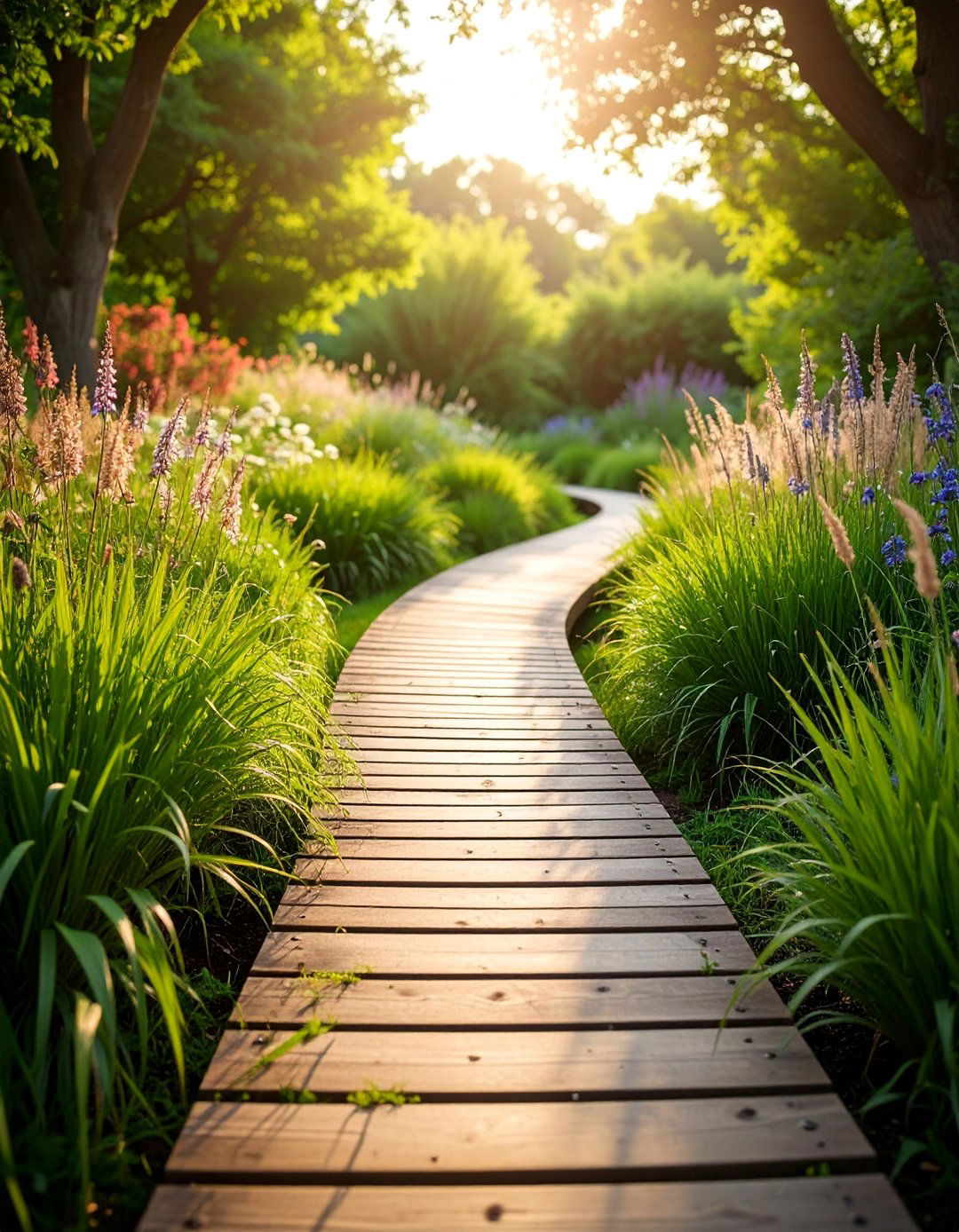
Gently curving boardwalks through ornamental grasses create immersive experiences that change dramatically with seasonal growth patterns. This design features subtle bends that reveal new vistas gradually while encouraging leisurely exploration. Construct using flexible framing techniques that allow gentle curves without tight angles. The elevated pathway protects ornamental grasses while providing intimate passage through textural plantings. Select grass varieties with multiple seasons of interest, such as fountain grass or feather reed grass, that create enclosure without blocking distant views. The interaction between rigid wooden structure and flowing plant movement creates dynamic visual contrast. Strategic placement takes advantage of prevailing winds that animate the grasses, creating natural sound and movement that enhances the sensory walkway experience.
9. Floating Platform Stepping Stones
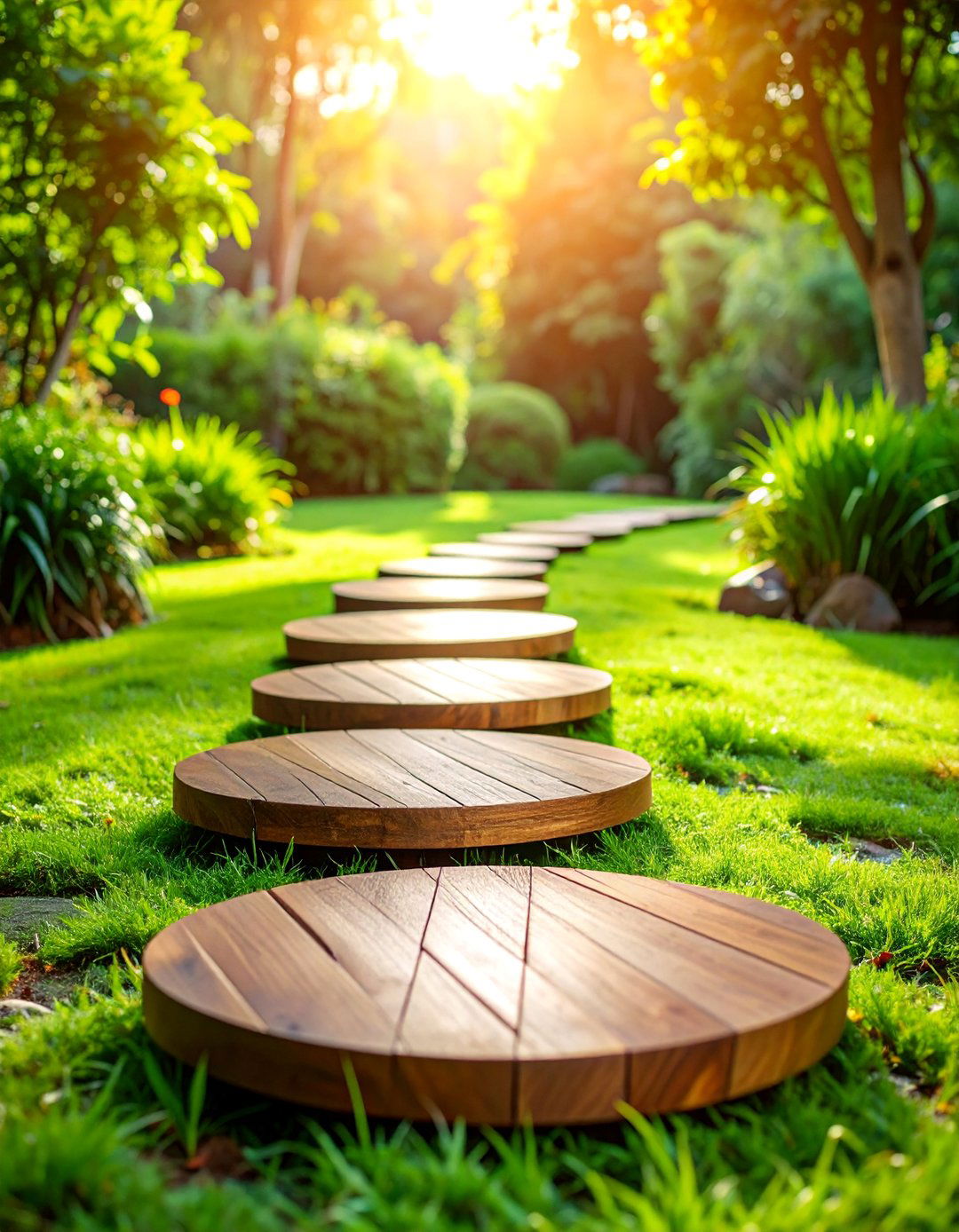
Floating timber stepping platforms create rhythmic pathways that appear to hover over ground covers or shallow water features. This design uses individual wooden platforms spaced at comfortable walking intervals, connected by hidden underground supports. Each platform functions independently while maintaining visual continuity across the pathway. Construct platforms using thick hardwood planks with rounded edges for safety and aesthetic appeal. The gaps between platforms allow plantings to flow underneath, creating the illusion of floating wooden islands. This approach works exceptionally well over decorative gravels, moss, or low groundcovers. The spacing can be adjusted to create varying walking rhythms, from quick passage to contemplative stepping that encourages slower garden appreciation and observation.
10. Wide Wooden Boardwalk with Integrated Benches
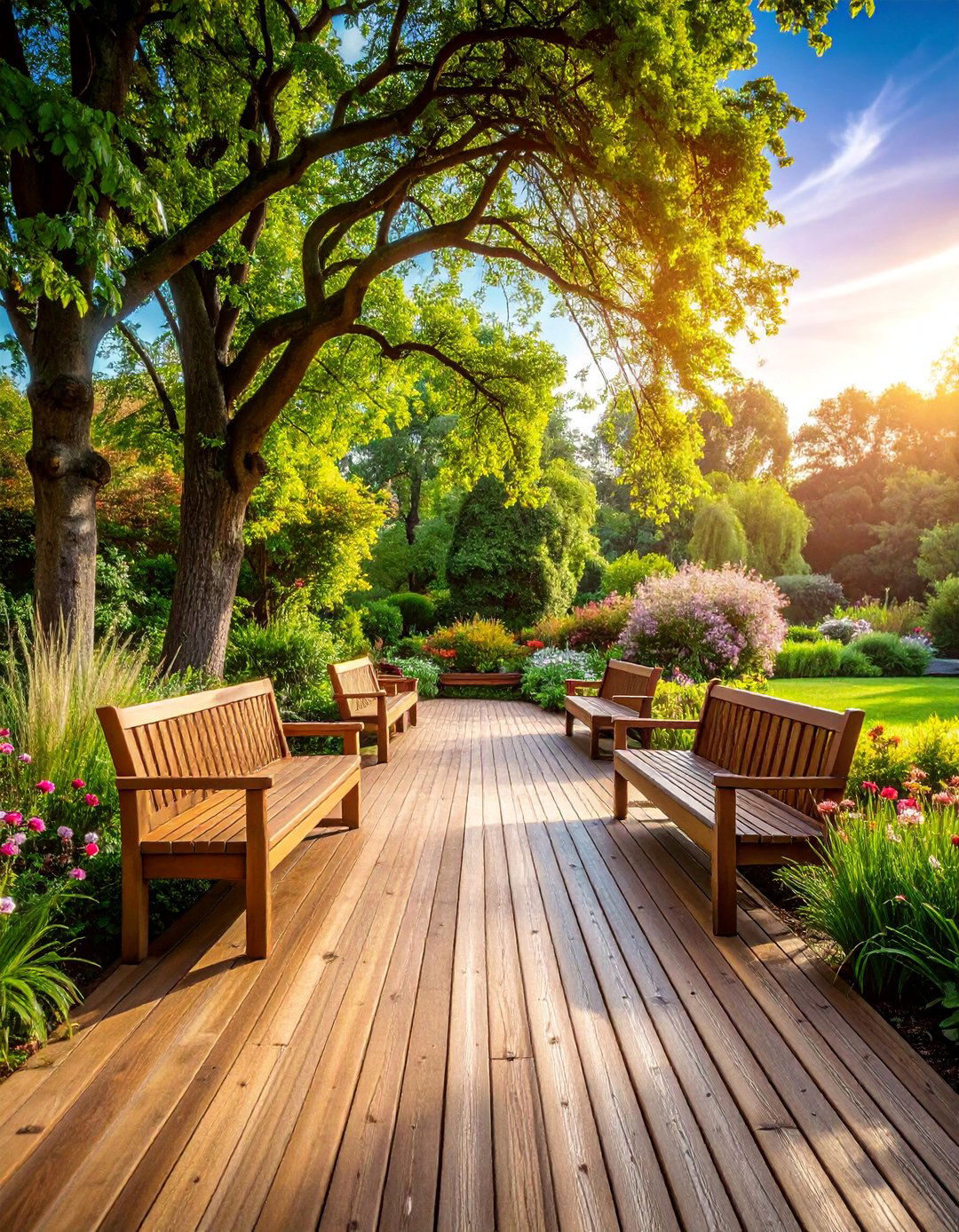
Wide boardwalks incorporating built-in seating areas transform pathways into social spaces for relaxation and garden enjoyment. This generous design features substantial width with periodic bench sections that invite pausing and conversation. Construct using heavy timber framing capable of supporting multiple users while maintaining structural integrity. The benches face different directions to take advantage of various garden views and seasonal changes. Integrated planters along the edges soften the structure while providing color and fragrance close to seating areas. This design works particularly well for larger properties where the walkway becomes a destination rather than simply a means of passage. The combination of movement and rest creates flexible outdoor living space that accommodates various activities and gatherings.
11. Natural Log Slice Pathway
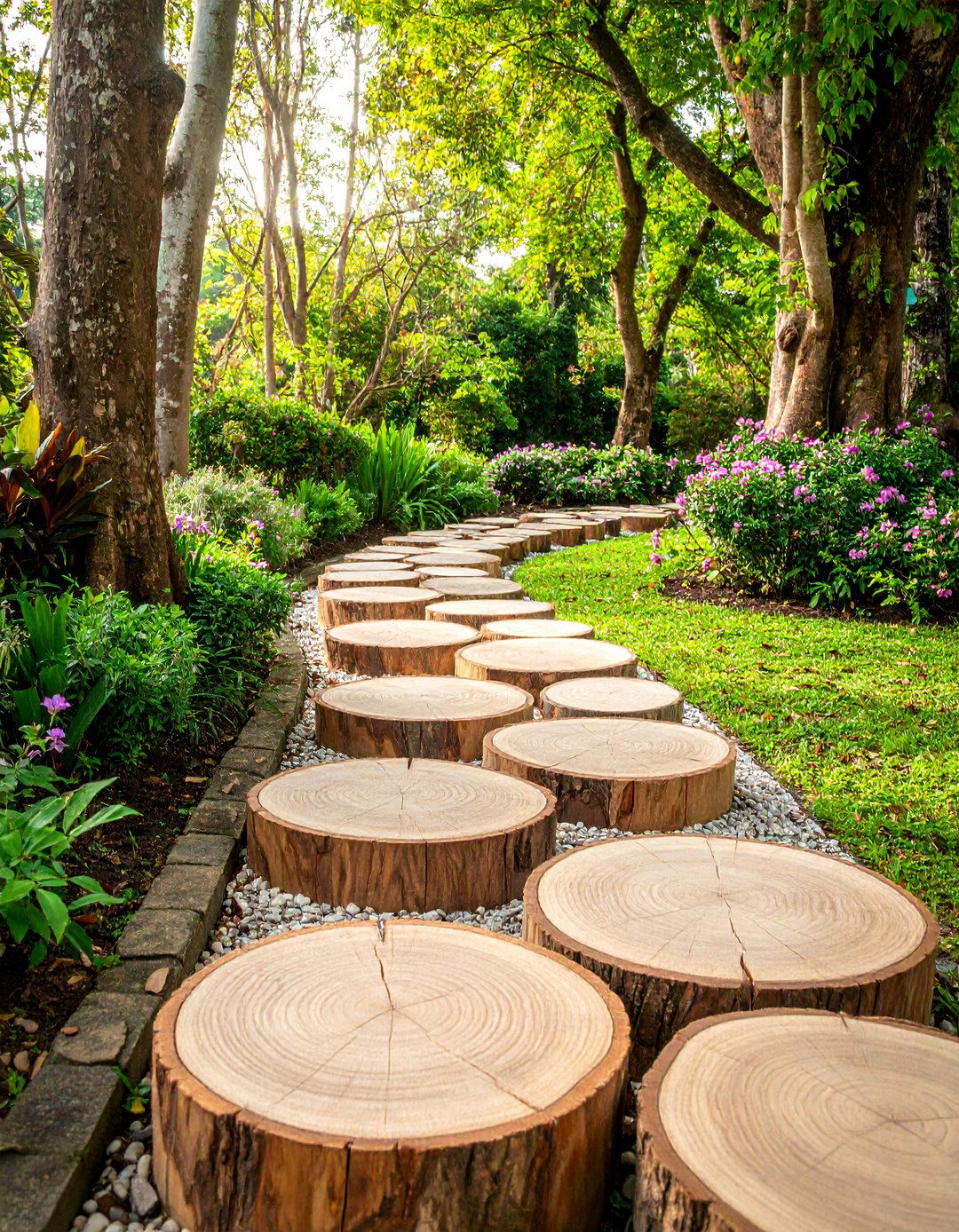
Natural log pathways crafted from whole logs or thick trunk slices bring organic textures that harmonize perfectly with woodland landscapes. This design celebrates wood's natural form, using cross-cut sections of varying diameters to create stepping stones with authentic character. Install logs directly on graded soil or sand base, allowing natural settling over time. The irregular shapes and varying heights create engaging walking experiences while accommodating natural terrain variations. Choose naturally rot-resistant species like cedar or locust for longevity without chemical treatments. Moss and small plants naturally colonize gaps between logs, enhancing the organic aesthetic. This approach works beautifully in naturalistic gardens where formal pathways would feel inappropriate, creating trails that seem to have evolved naturally within the landscape.
12. Illuminated Wooden Walkway with LED Integration

Integrated lighting transforms wooden walkways from daytime functional elements into dramatic nighttime features. This design incorporates LED strips or recessed fixtures directly into the walkway structure for safety and ambiance. Install low-voltage lighting systems between boards, along edges, or underneath elevated sections to create gentle illumination. Modern smart controls allow adjustment of brightness and color throughout evening hours. The lighting enhances wood grain visibility while defining pathway edges for safe navigation. Solar-powered options provide sustainable operation without electrical connections. Strategic lighting placement can highlight surrounding plantings while creating dramatic shadows and depth. This approach extends garden enjoyment into evening hours while providing practical illumination for year-round use, transforming simple pathways into sophisticated landscape features.
13. Crosshatch Woven Wood Platform
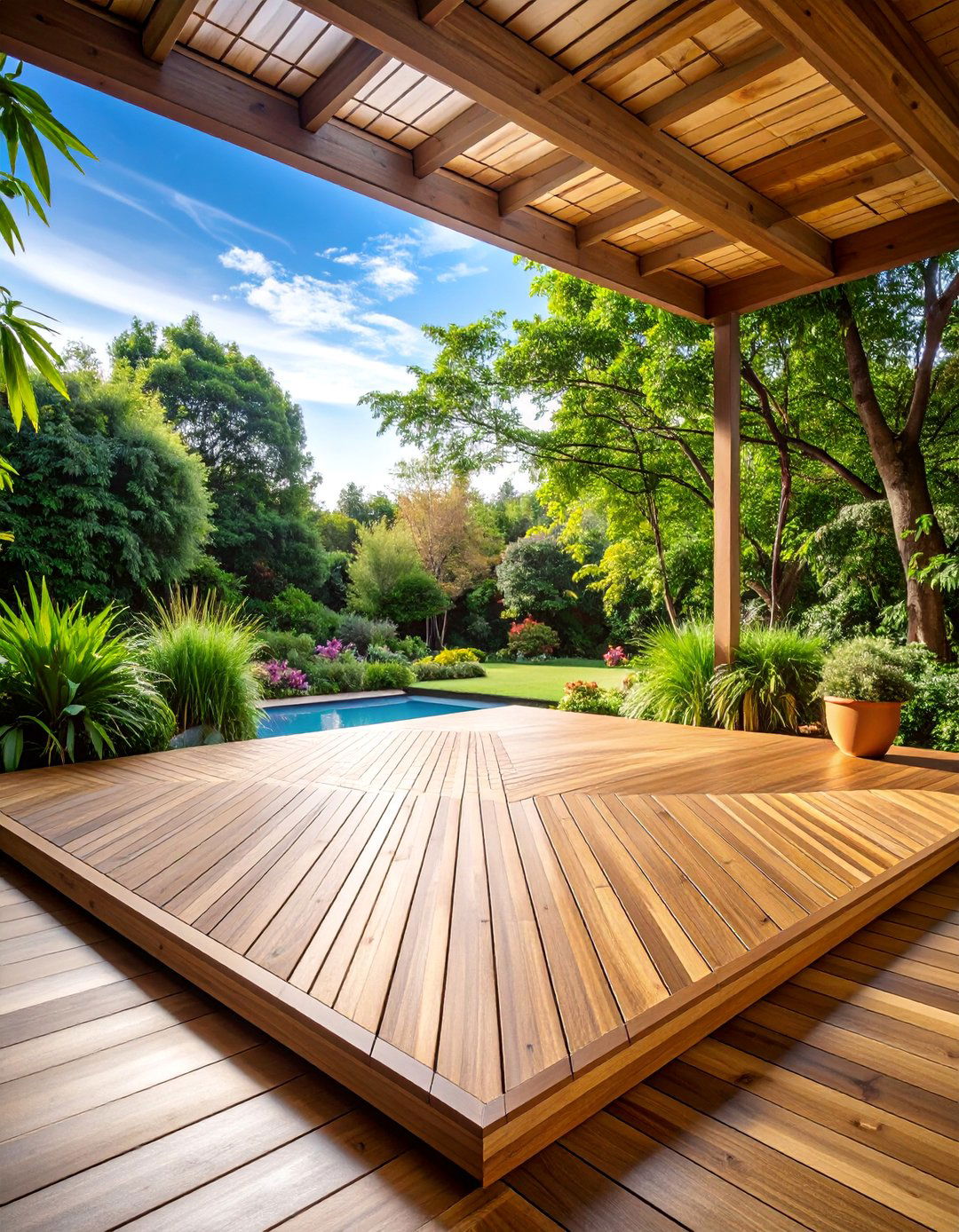
Drawing inspiration from traditional Japanese tatami construction, woven wood platforms create stunning visual patterns through alternating board directions. This intricate design requires precise craftsmanship but results in exceptionally strong structures that distribute weight across multiple contact points. Create the weaving effect by alternating horizontal and vertical board orientations in regular patterns. This technique works best for defined platform areas rather than long continuous pathways. Consider using different wood species or varied finishes to enhance the woven pattern through subtle color variations. The interlocking construction provides inherent structural stability while creating sophisticated visual texture. This design serves as architectural focal points in meditation gardens, entrance areas, or transitional spaces where artistic expression enhances functional pathway requirements.
14. Weathered Driftwood Style Walkway
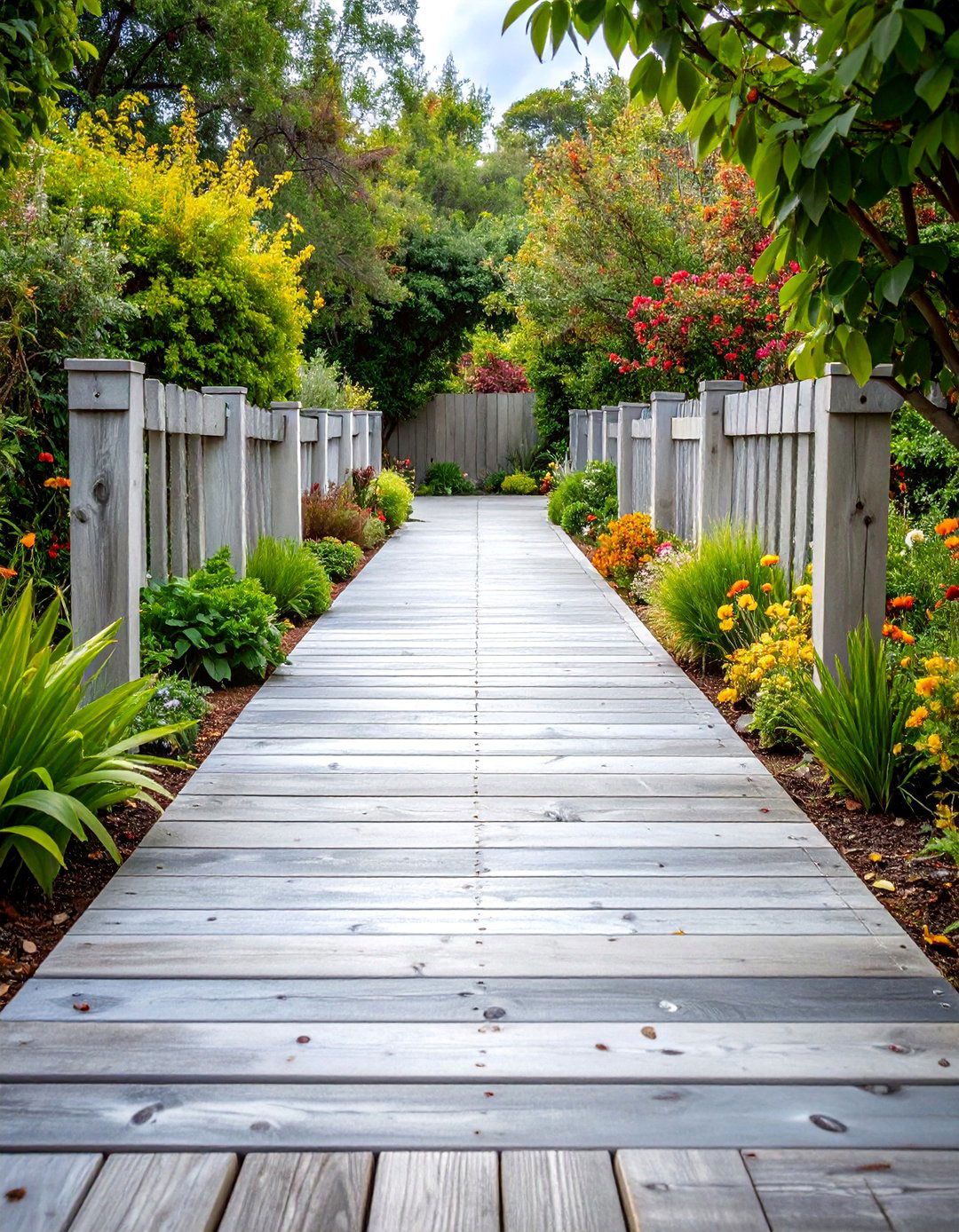
Weathered wood walkways achieve timeless character through natural aging processes that create silver-grey patina and distinctive surface textures. This design celebrates wood's natural weathering, using untreated materials that develop beautiful coloration over time. Start with naturally weather-resistant species like cedar or redwood, allowing UV exposure and moisture to create authentic patina. The silvered appearance complements coastal gardens, cottage landscapes, and informal outdoor settings. Irregular plank widths and varied weathering patterns add visual interest while maintaining functional pathway requirements. This low-maintenance approach eliminates need for stains or sealers while developing increasingly attractive appearance over time. The weathered aesthetic blends seamlessly with vintage garden accessories and heritage plantings, creating pathways that feel established and naturally integrated within landscape settings.
15. Stepped Wooden Trail for Sloped Gardens
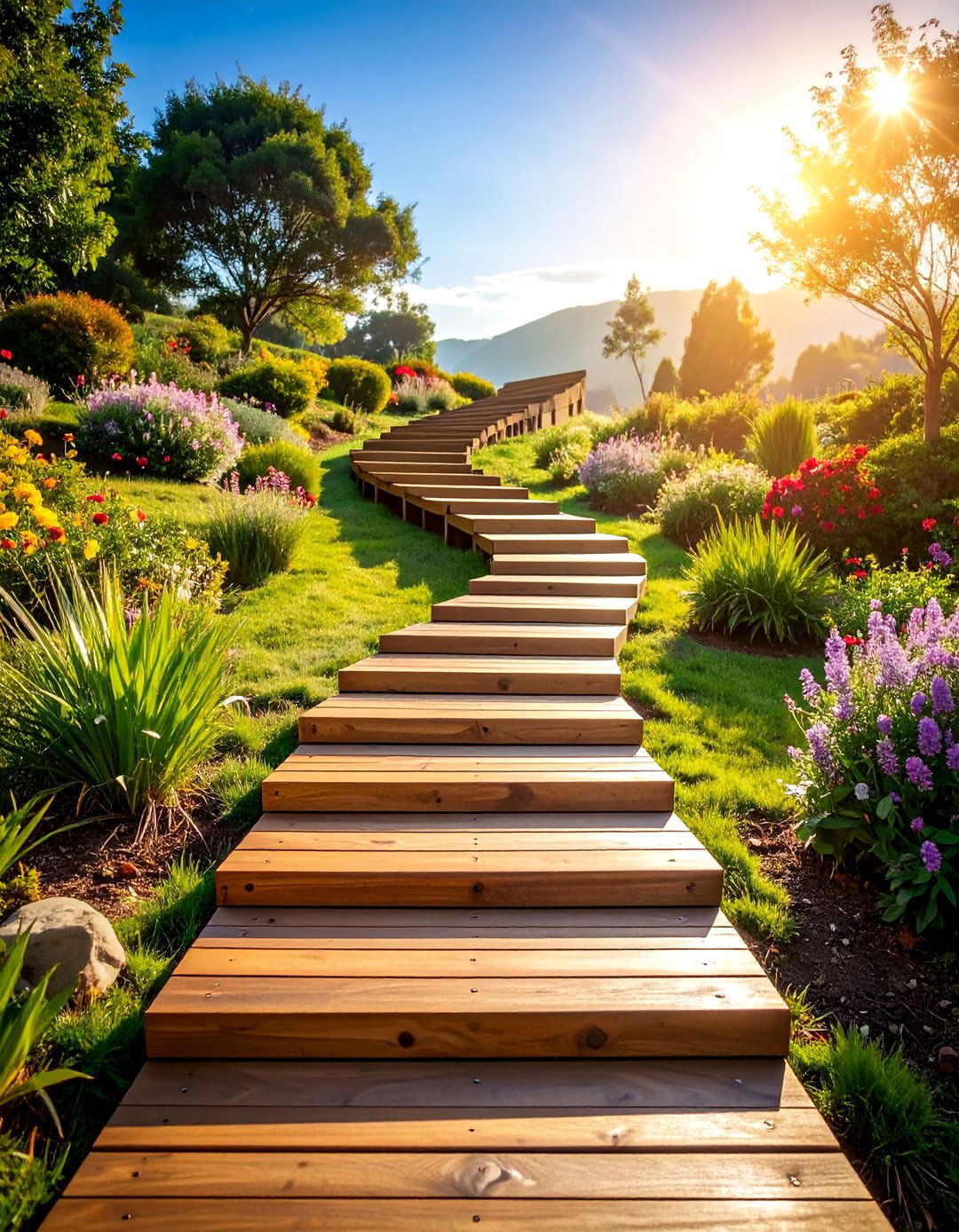
Stepped timber pathways provide safe navigation through sloped terrain while creating geometric rhythm and visual interest. This design incorporates regular steps with intermediate landings to accommodate significant elevation changes comfortably. Construct using heavy timber risers filled with gravel or crushed stone for drainage and stability. The geometric landings create natural stopping points while providing level surfaces for seating or plant displays. Handrails can be added for safety on steeper sections, using materials that complement the timber construction. Strategic placement of steps follows natural contours while maintaining consistent rise and run measurements. This approach transforms challenging topography into an advantage, creating dramatic pathways that celebrate elevation changes while ensuring safe and comfortable access to all garden areas throughout the seasons.
16. Pallet Wood Garden Path
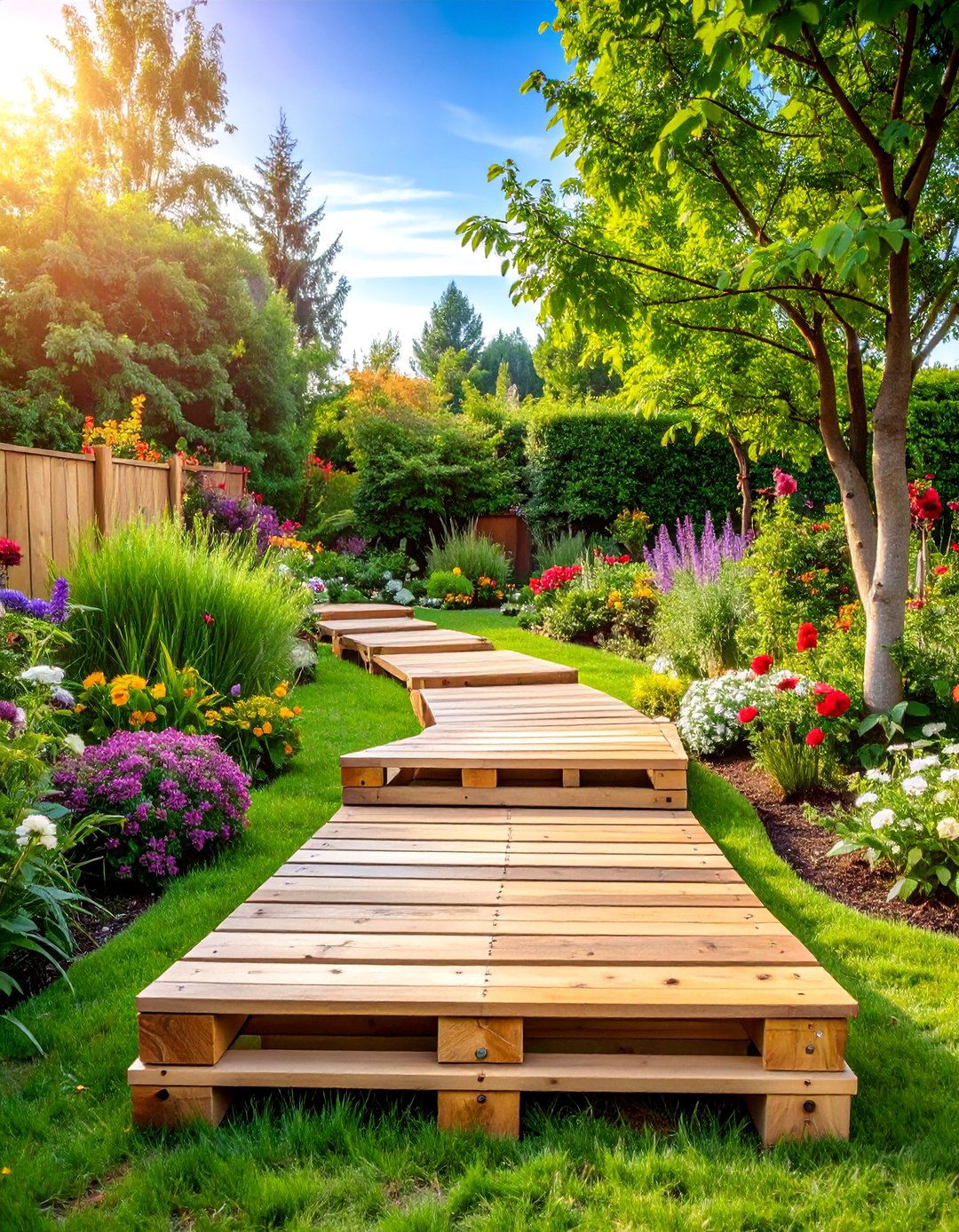
Repurposed wooden pallets create budget-friendly pathways while demonstrating environmental responsibility through creative material reuse. This sustainable design disassembles standard shipping pallets, using individual boards to construct rustic garden paths. Sand and stain the reclaimed wood for refined appearance, or leave natural for authentic weathered character. The varied board widths and existing wear patterns create organic visual texture that complements informal garden settings. Install pallets directly on level ground or create simple frames for elevated installation. This DIY-friendly approach allows creative arrangement of different pallet sizes and conditions for unique pathway configurations. The cost-effective solution provides attractive walkways while reducing waste, making sustainable gardening practices visible and accessible to environmentally conscious homeowners seeking functional outdoor improvements.
17. Composite Wood Alternative Boardwalk
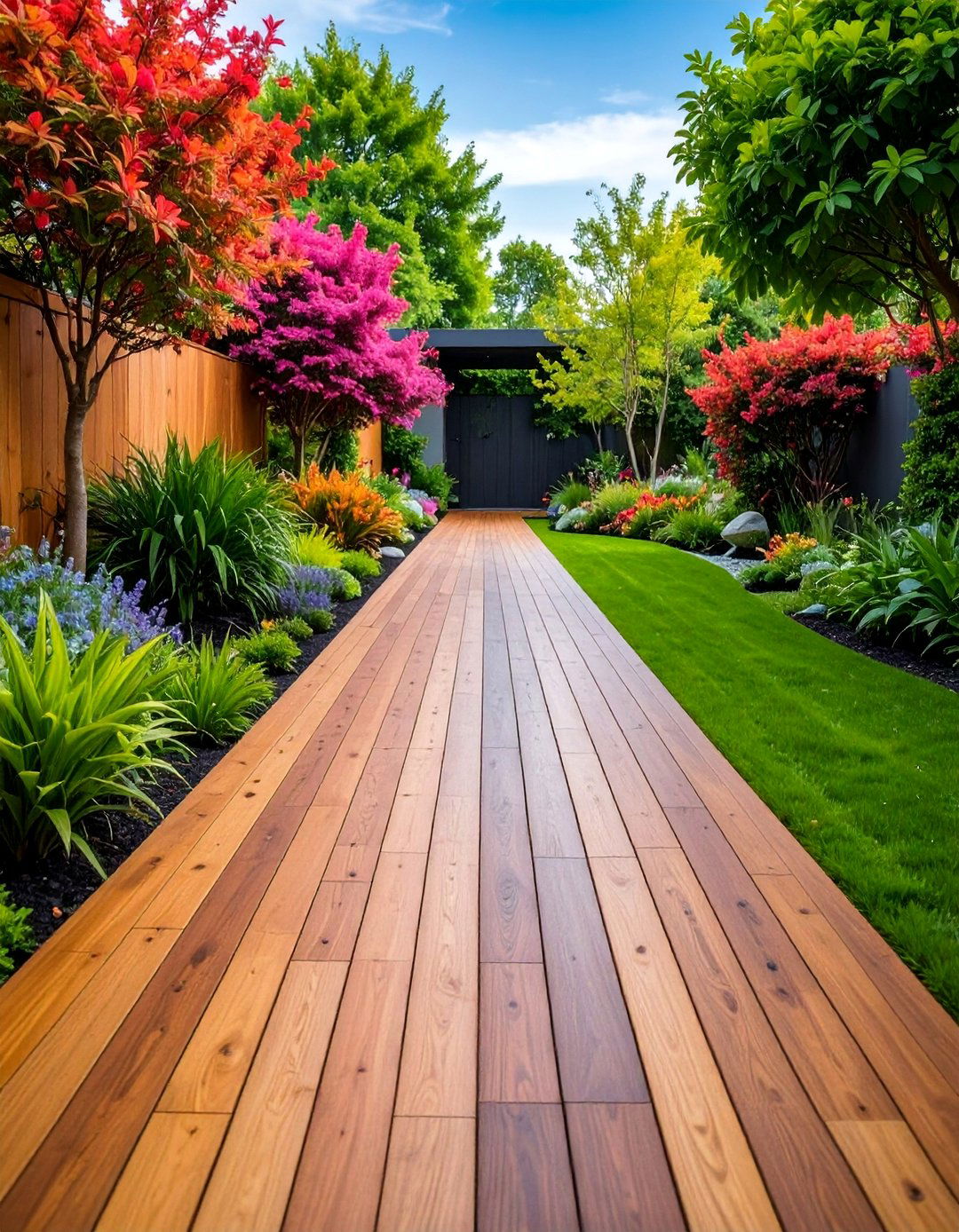
Modern composite materials replicate natural wood appearance while providing enhanced durability and reduced maintenance requirements. This contemporary approach combines wood fibers with recycled plastics, creating materials that resist moisture, insects, and UV degradation. The consistent coloration and texture provide uniform appearance while eliminating natural wood's seasonal expansion and contraction issues. Available in various colors and finishes, composite boards can match specific design preferences while providing long-term performance. Installation follows traditional wooden walkway techniques using appropriate fasteners designed for composite materials. This option suits homeowners prioritizing low maintenance over natural authenticity, providing attractive pathways that maintain appearance for decades without staining, sealing, or replacement requirements while supporting environmental sustainability through recycled content utilization.
18. Natural Edge Live-Edge Wooden Planks

Natural edge wooden slabs preserve original tree contours along one side, creating unique pathways that celebrate wood's organic form. This distinctive design showcases each plank's individual character, with bark edges and irregular curves that resist uniformity. Source materials from local sawmills or tree services for authentic regional character and sustainable practices. The varying widths and organic shapes create engaging walking surfaces that connect visitors directly with natural materials. Install live-edge planks on stable foundations to prevent settling while preserving their distinctive profiles. This approach works exceptionally well in woodland gardens, naturalistic landscapes, or artistic installations where conventional pathways would feel inappropriate. The unique character of each plank ensures no two pathways are identical, creating truly personalized outdoor features with authentic natural beauty.
19. Geometric Wooden Decking Patterns
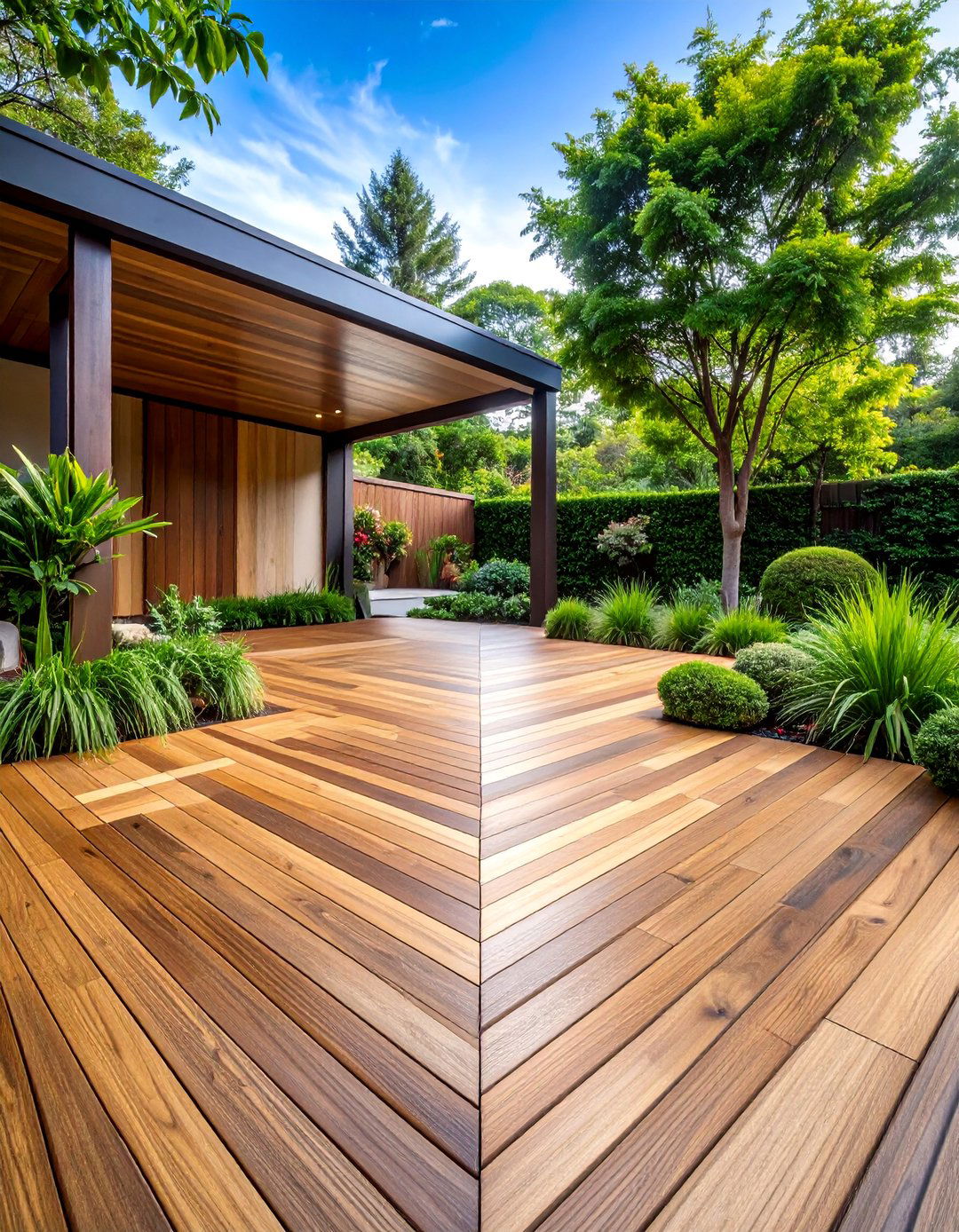
Geometric wooden patterns transform standard decking into artistic pathway statements through creative arrangement and varied staining techniques. This design approach uses standard lumber arranged in diamonds, chevrons, or other angular patterns that create visual excitement. Alternate wood tones through selective staining or species mixing to emphasize geometric designs. The precise angular arrangements require careful measurement and cutting but result in sophisticated pathways that function as landscape art. These patterns work particularly well for front entrances or formal garden settings where architectural precision complements surrounding design elements. The geometric approach can incorporate different plank sizes and orientations while maintaining overall pattern integrity. Strategic placement of contrasting patterns creates focal points while ensuring the walkway remains functional and visually engaging throughout all seasons and lighting conditions.
20. Rustic Log Bridge Walkway
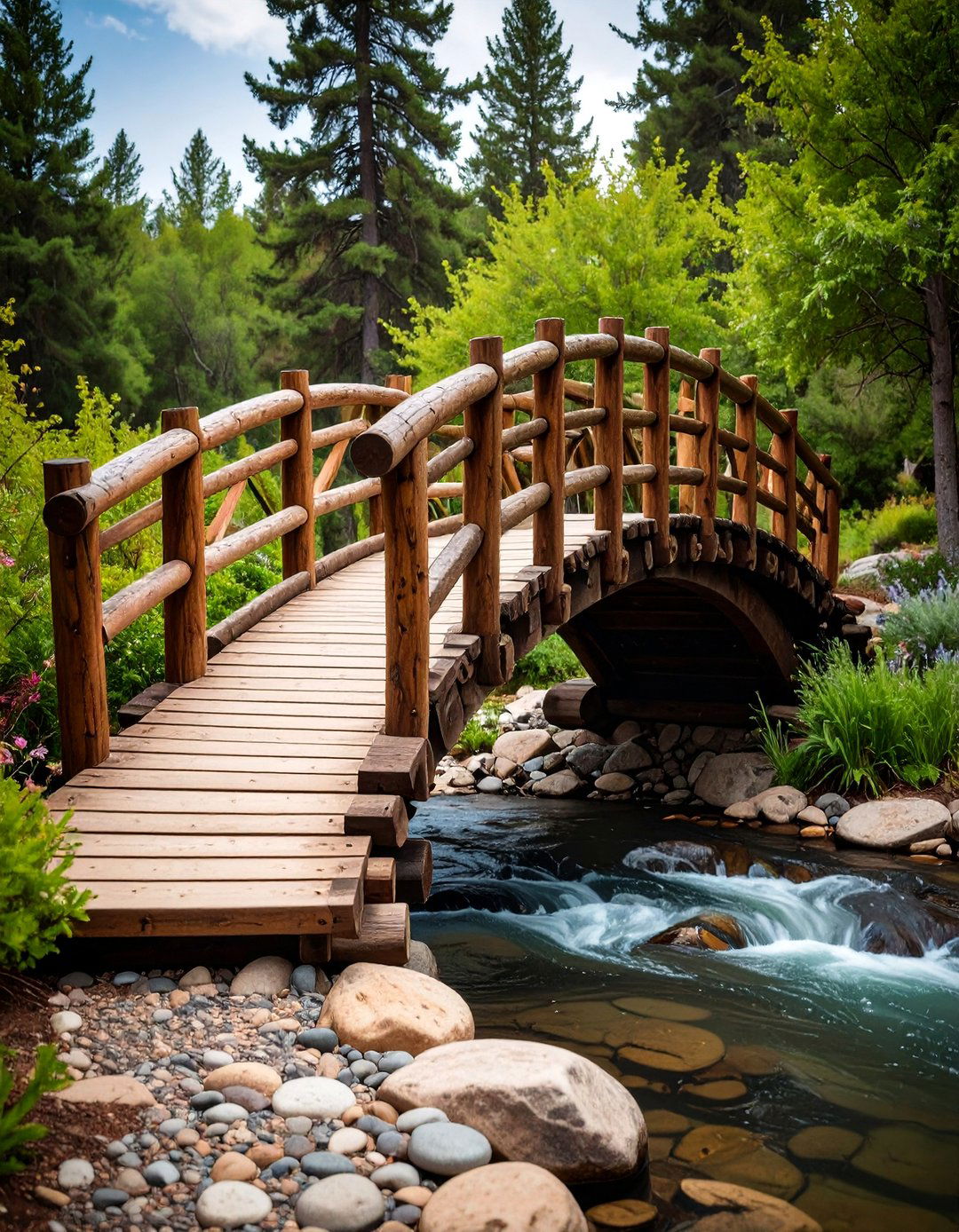
Curved wooden bridges spanning dry creek beds or small water features create stunning focal points while providing functional passage between garden areas. This design incorporates gentle arches that invite exploration while showcasing craftsmanship and natural materials. Construct using laminated beams or naturally curved timbers that support both structural requirements and aesthetic preferences. The elevated perspective provides unique garden viewpoints while creating dramatic shadows and depth. Decorative railings can incorporate lattice work, branch materials, or artistic metalwork that complements the rustic character. This approach transforms necessary garden crossings into destination features that encourage pausing and appreciation. The bridge design works equally well over actual water features or decorative dry landscapes, creating architectural interest while maintaining natural harmony with surrounding landscape elements and seasonal changes.
21. Ground-Level Floating Deck Sections
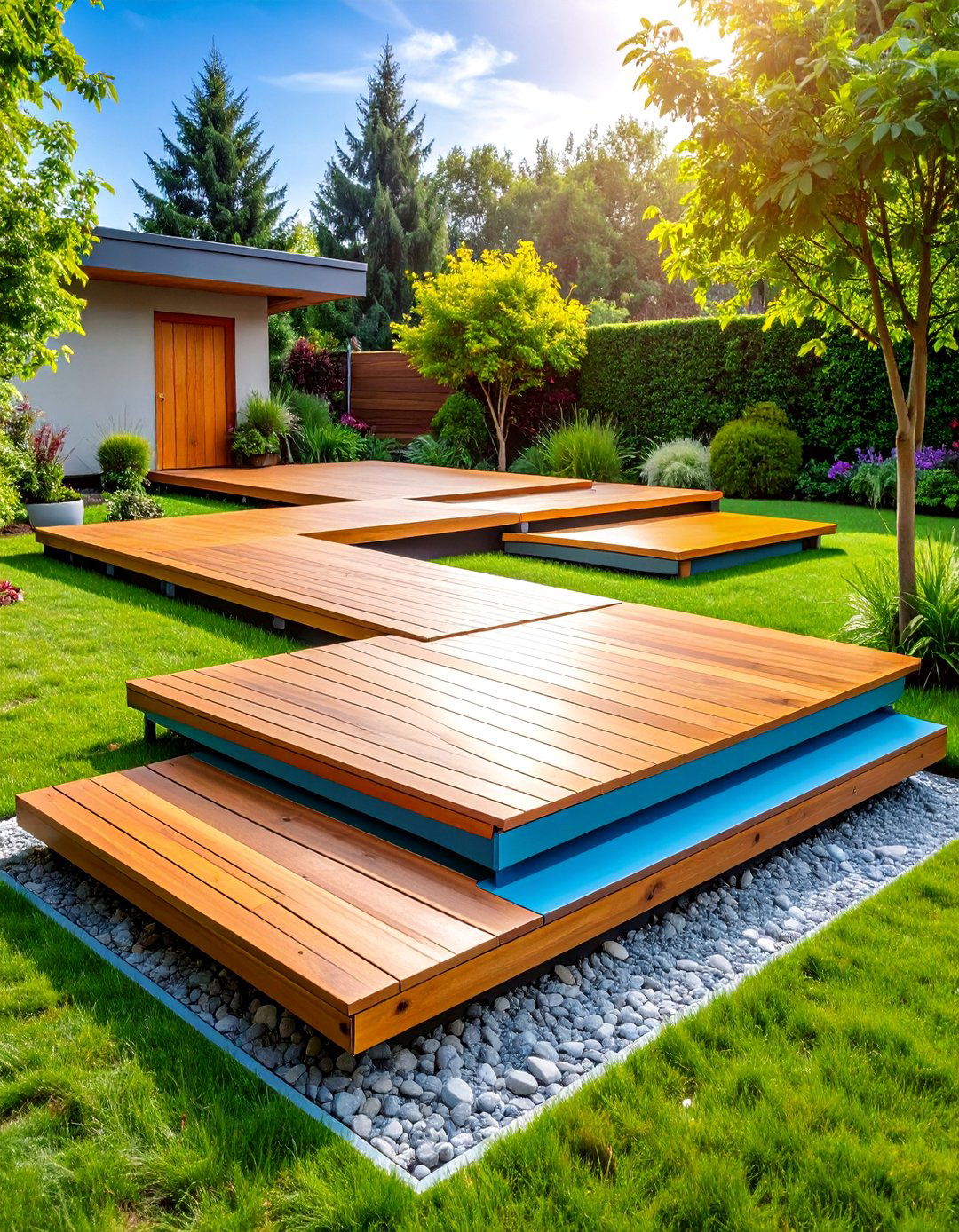
Ground-level floating sections provide stable pathways without permanent foundation requirements, ideal for temporary installations or rental properties. This modular approach uses prefabricated sections that rest directly on graded surfaces, allowing easy relocation or seasonal removal. Construct individual modules using pressure-treated framing with cedar or composite decking for weather resistance. The sectional design accommodates ground irregularities while maintaining level walking surfaces through adjustable supports. This approach minimizes ground disturbance while providing attractive pathways that can evolve with changing landscape needs. The modules can incorporate different sizes and configurations to create custom pathway layouts. This flexible solution suits homeowners who prefer temporary installations or those planning future landscape modifications while maintaining immediate functional and aesthetic pathway requirements.
22. Wide Plank Minimalist Design
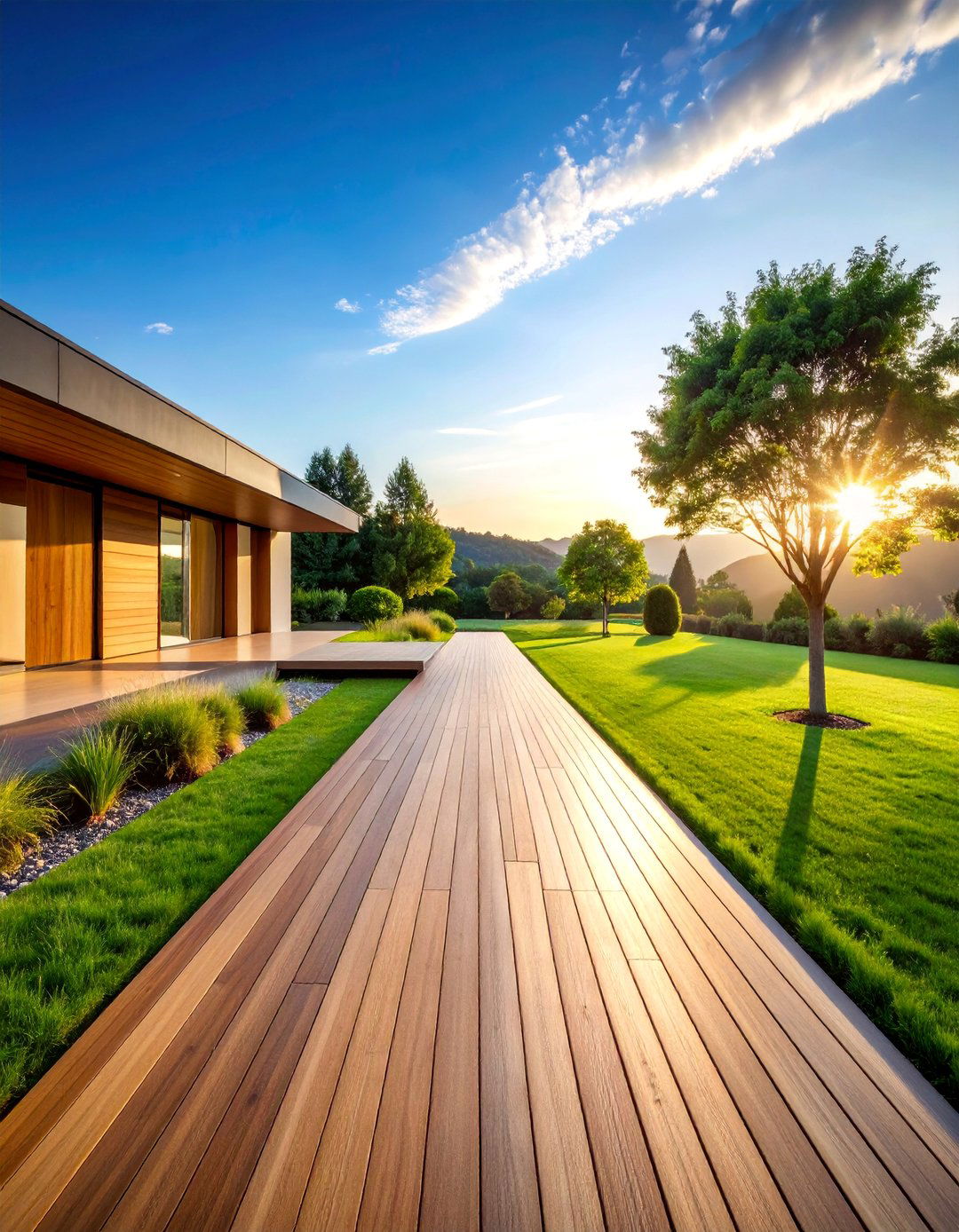
Contemporary wide-plank walkways emphasize material simplicity through generous board dimensions and clean geometric lines. This minimalist approach uses fewer, larger boards to create uncluttered visual statements that complement modern architecture and landscapes. Choose premium hardwood species with consistent grain patterns for refined appearance, or select materials with distinctive character for subtle visual interest. The reduced joint lines create smooth walking surfaces while emphasizing each board's natural beauty. This design requires careful material selection and precise installation to achieve sophisticated results. The wide planks can accommodate various staining techniques or natural finishes that enhance wood's inherent qualities. This approach suits contemporary gardens where simplicity and material quality take precedence over decorative complexity, creating elegant pathways that age gracefully while maintaining sophisticated appearance.
23. Serpentine Curved Wooden Trail
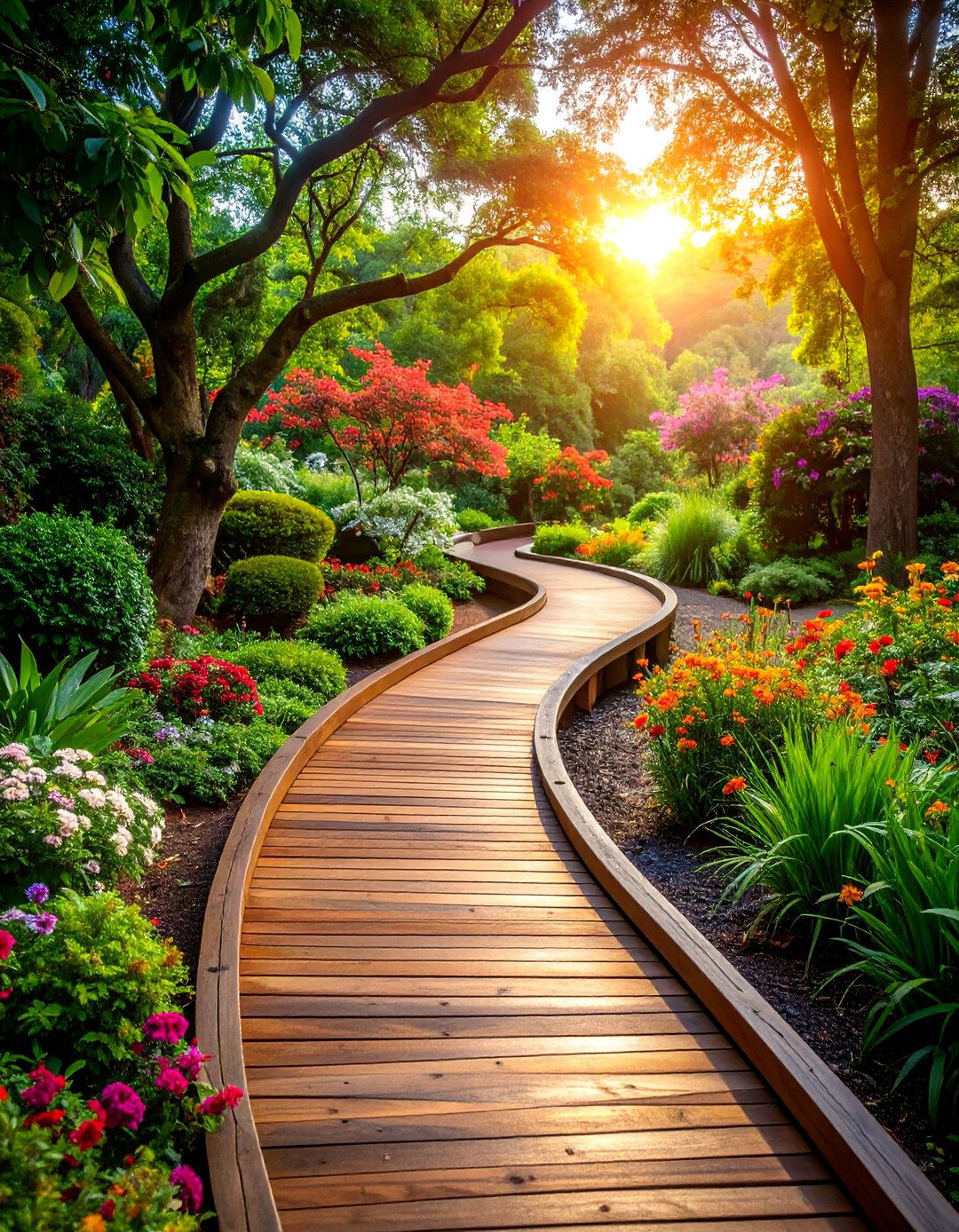
Meandering curved pathways create whimsical garden journeys that reveal new vistas around each gentle bend. This organic design follows natural landscape contours while encouraging leisurely exploration through different garden zones. The flowing curves require flexible construction techniques using laminated beams or multiple shorter sections joined seamlessly. Strategic curve placement takes advantage of existing vegetation and topography while creating natural focal points at direction changes. This approach transforms simple garden navigation into engaging experiences that slow visitor movement and encourage detailed observation. The serpentine form works beautifully through perennial borders, around water features, or between established trees. Plant selection along curves can emphasize seasonal changes and create varying degrees of enclosure that enhance the pathway's mysterious and inviting character throughout different times of year.
24. Terraced Wooden Steps with Landings
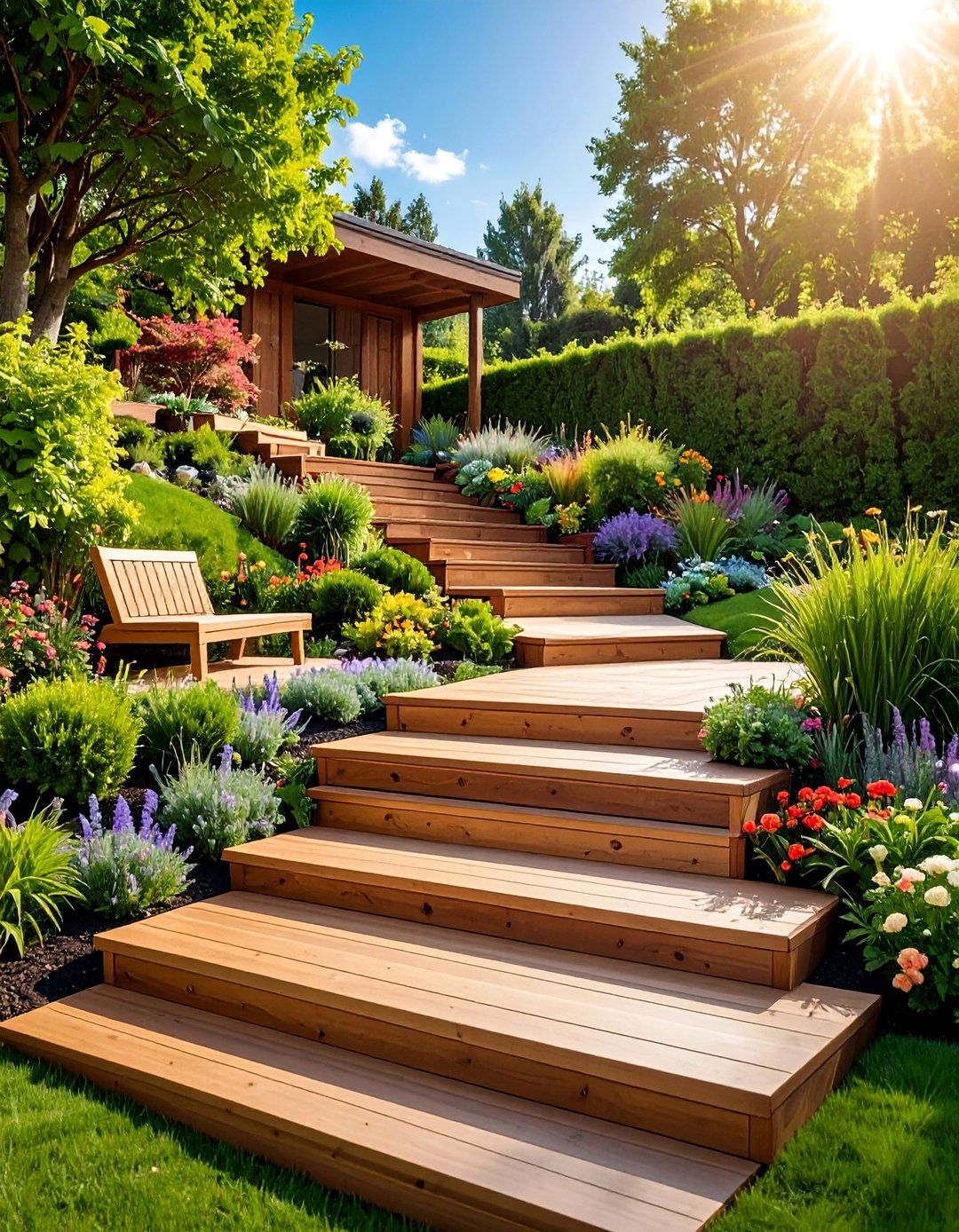
Terraced step systems with integrated landings provide comfortable navigation through significant elevation changes while creating architectural rhythm. This structured design incorporates regular platforms between step sections, allowing rest periods and varied viewing perspectives. Build using heavy timber construction with proper drainage systems that prevent water accumulation. The landings can accommodate seating, planters, or artistic elements that enhance the climbing experience. Strategic placement of intermediate platforms reduces perceived effort while creating opportunities for garden appreciation from different elevations. This approach works particularly well on hillside properties where traditional pathways would be too steep for comfortable use. The terraced design can incorporate lighting systems and handrails for safety while maintaining natural materials that harmonize with surrounding landscape elements and seasonal plantings that soften architectural edges.
25. Artistic Mosaic Wooden Pathway
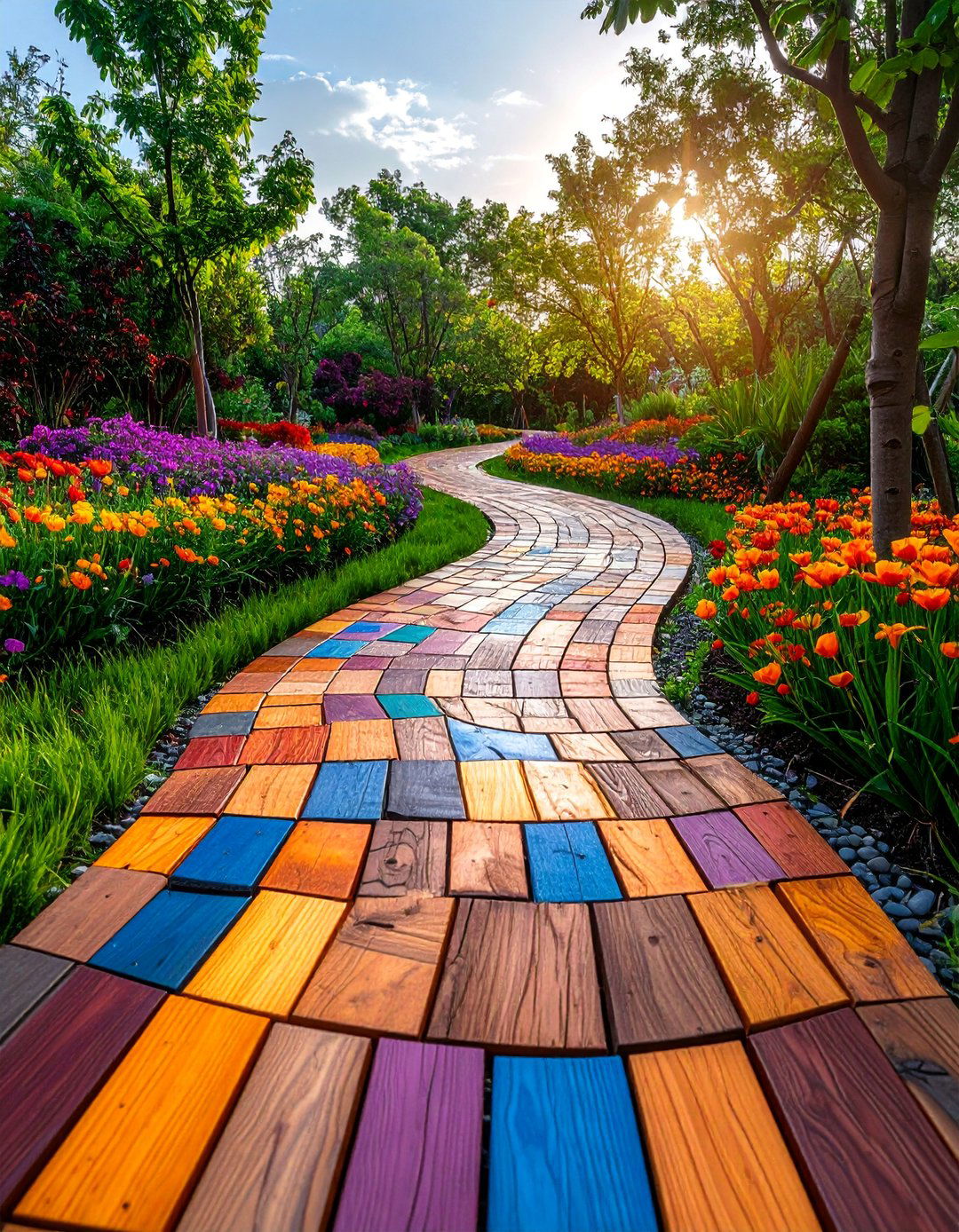
Mosaic wooden walkways combine different wood species, colors, and textures to create artistic pathway statements that function as landscape art. This creative approach uses varied materials arranged in deliberate patterns that express personal style and artistic vision. Incorporate contrasting wood species, different cut orientations, or selective finishing techniques to create complex visual compositions. The artistic arrangement requires careful planning and skilled installation but results in unique pathways that serve as conversation pieces. This design can incorporate salvaged materials, exotic species, or locally sourced woods that reflect regional character. The mosaic approach allows creative expression while maintaining functional pathway requirements. Strategic pattern placement can emphasize garden focal points or create visual movement that guides visitors through landscape sequences. This personalized approach ensures walkways become signature features that reflect individual creativity and enhance property character.
Conclusion:
Wooden walkways offer endless possibilities for enhancing outdoor spaces with natural beauty and functional design. From floating platforms over water to artistic mosaic patterns, these 25 ideas demonstrate wood's versatility in landscape applications. Each design approach serves different aesthetic preferences, functional requirements, and maintenance considerations while celebrating wood's timeless appeal. Whether choosing rustic reclaimed materials or contemporary composite alternatives, wooden pathways create inviting passages that connect people with nature while adding lasting value to outdoor environments.


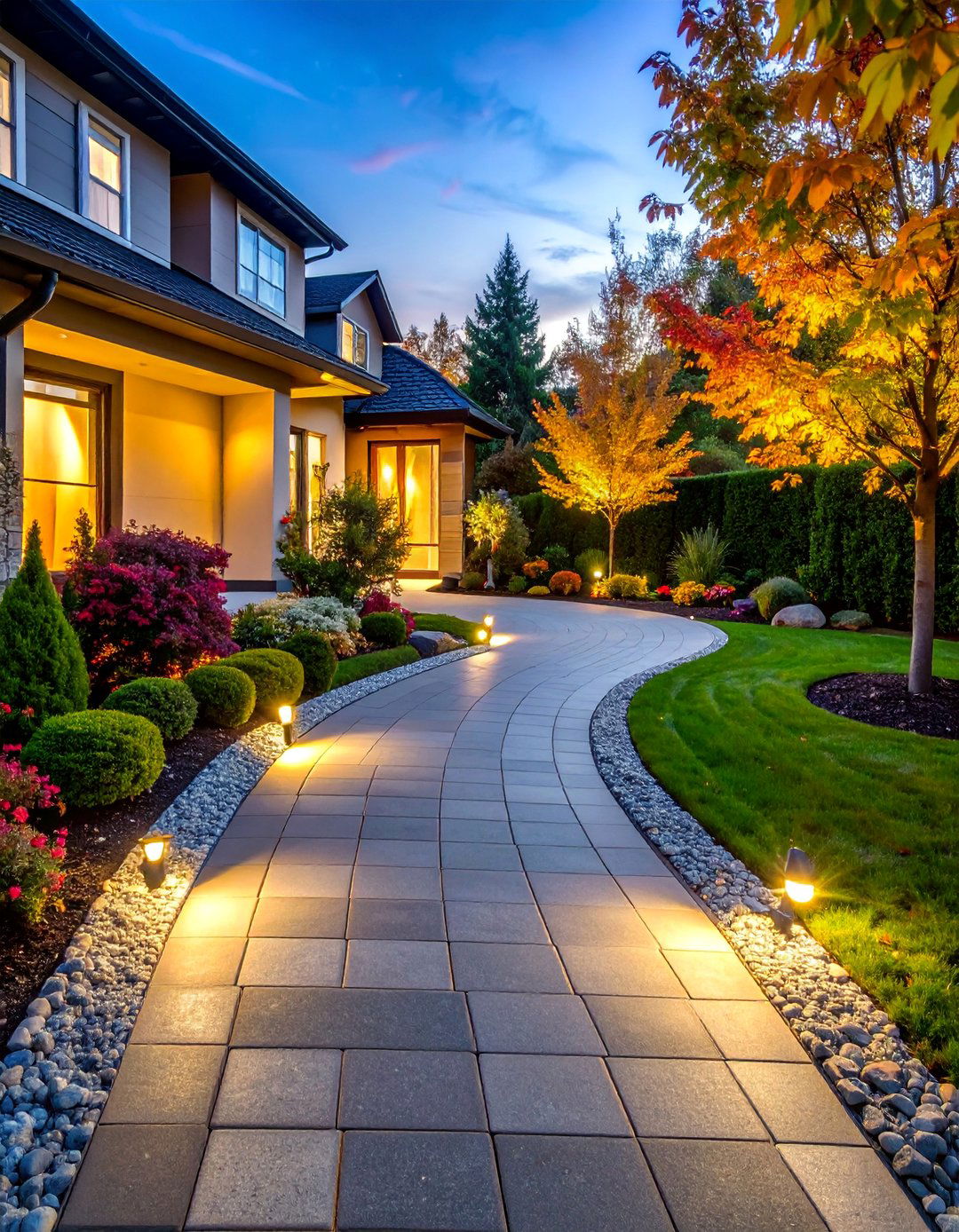
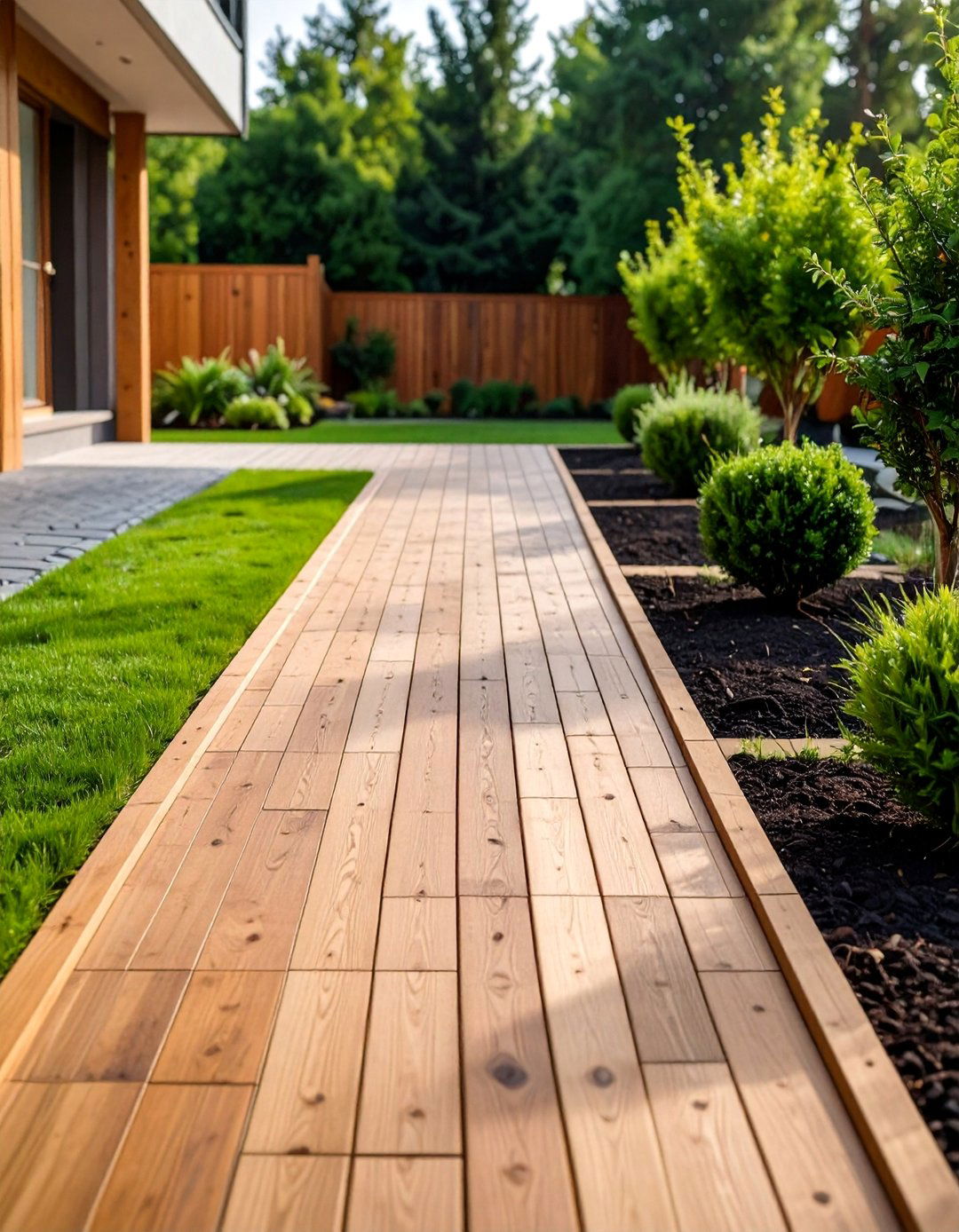
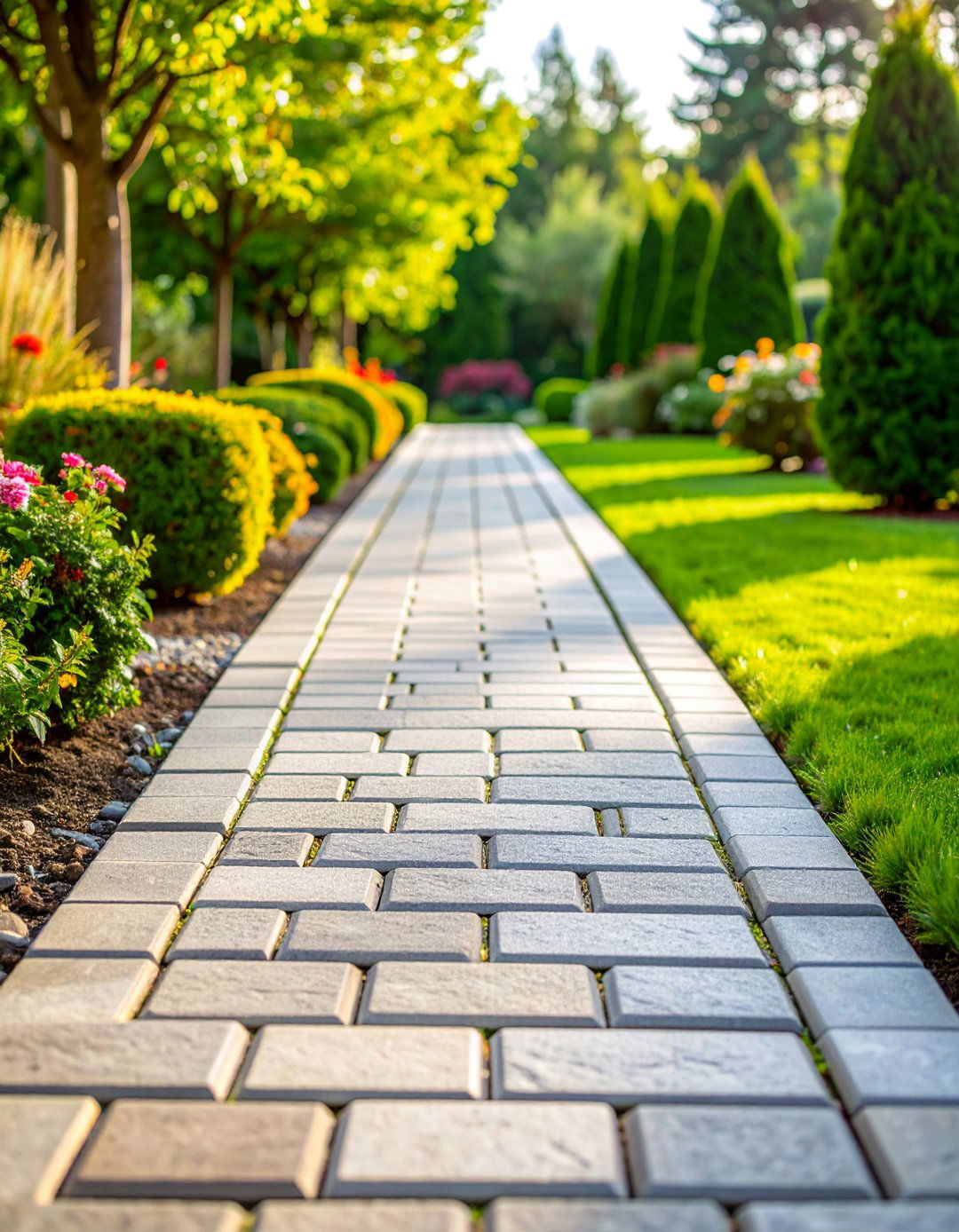

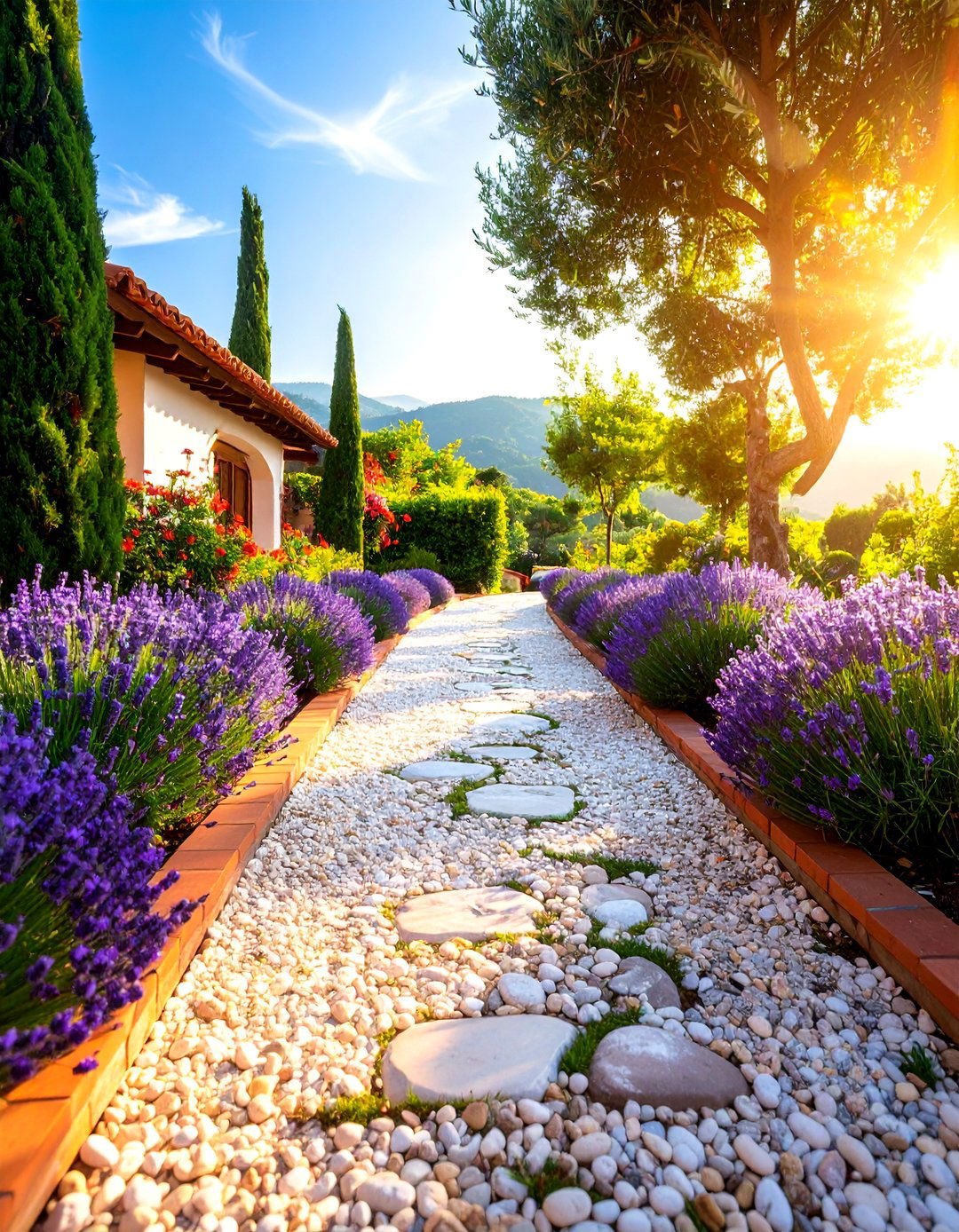
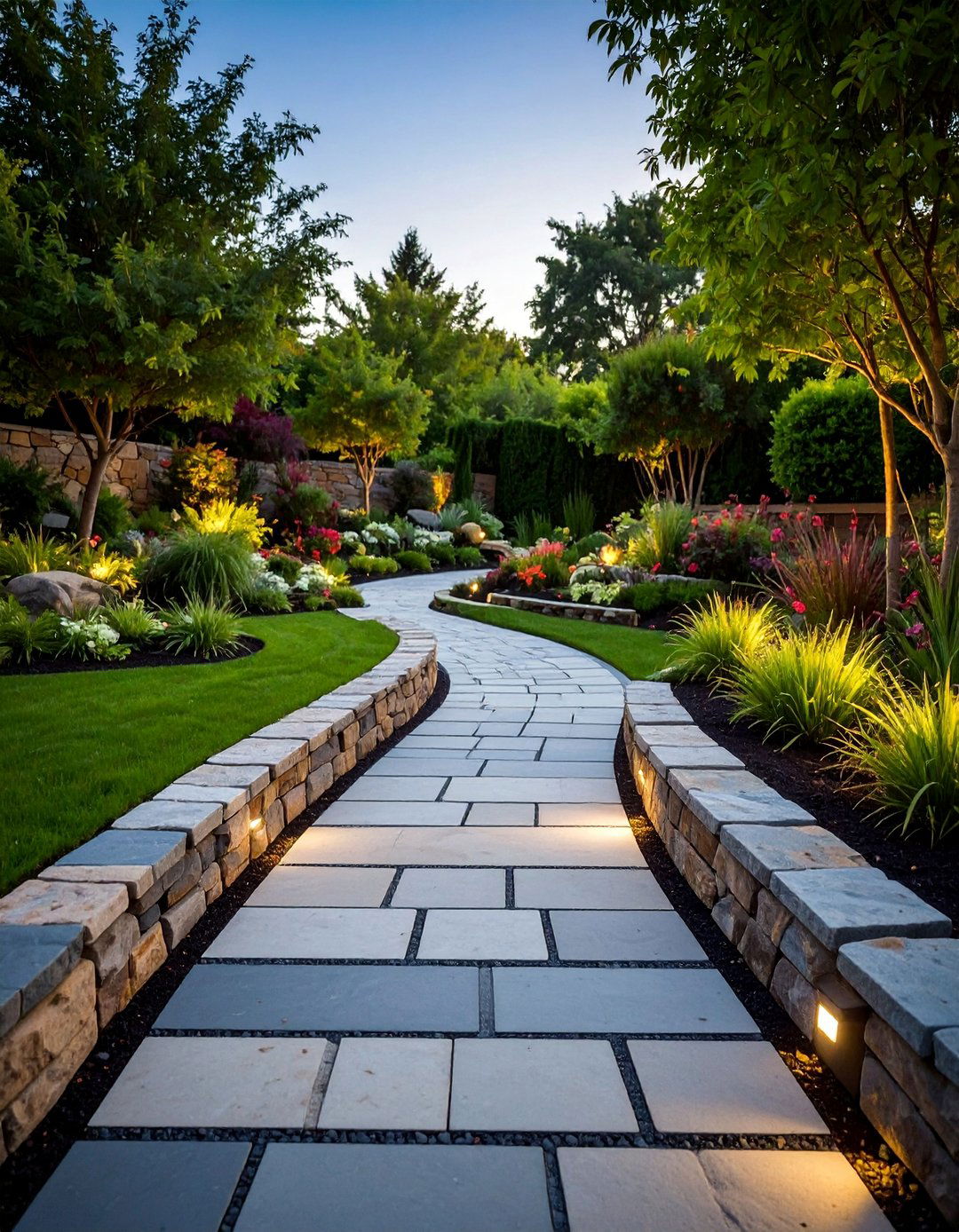
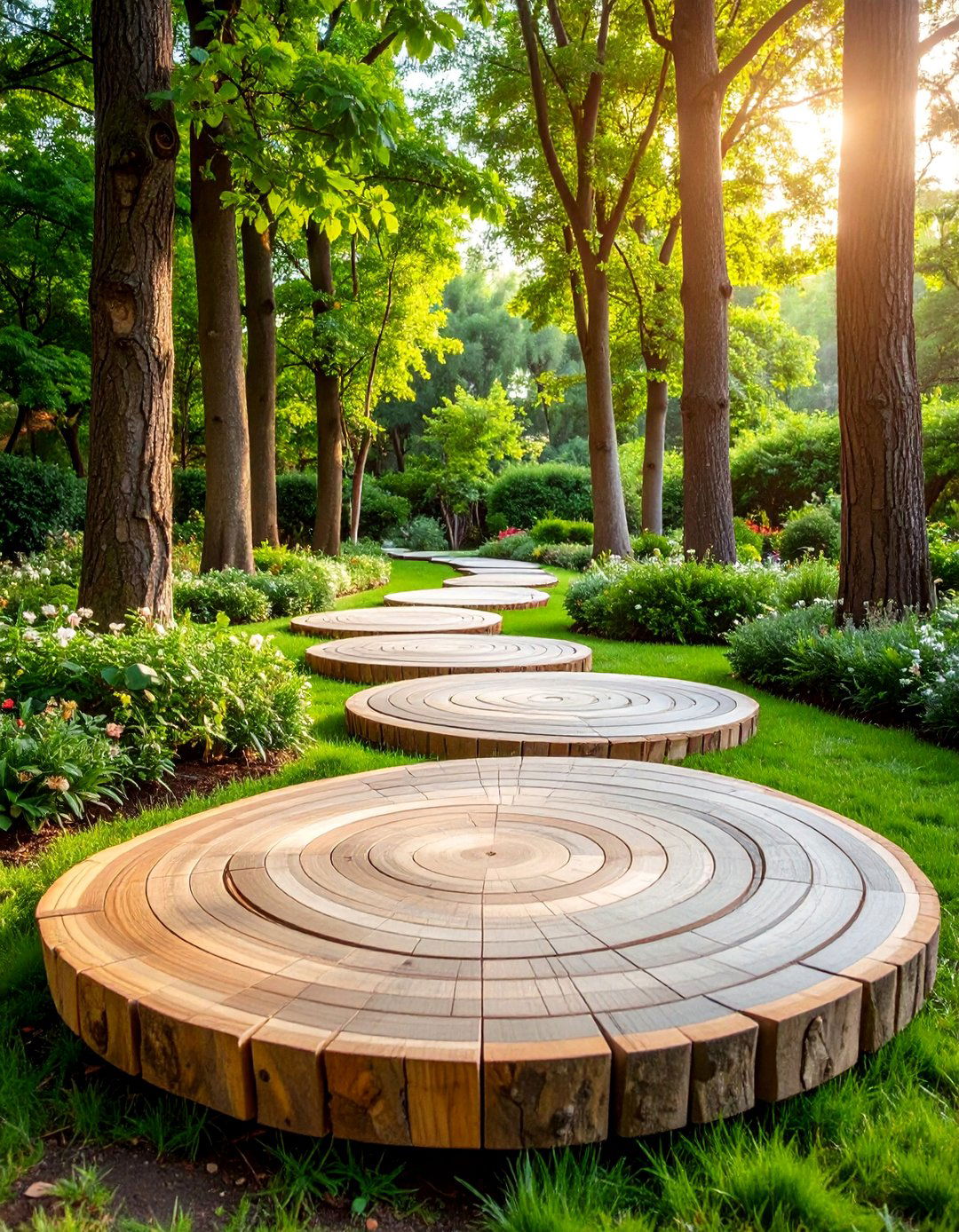
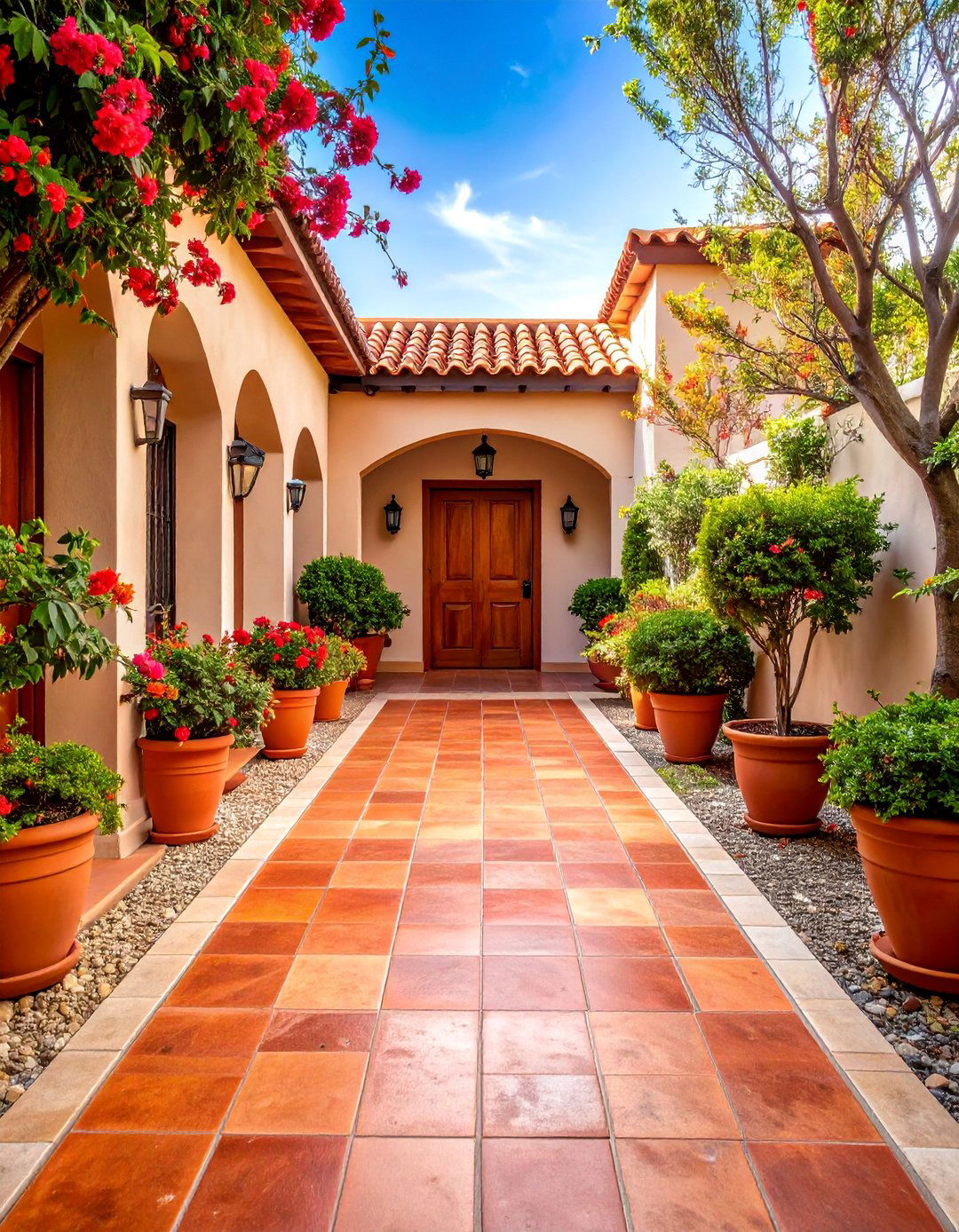


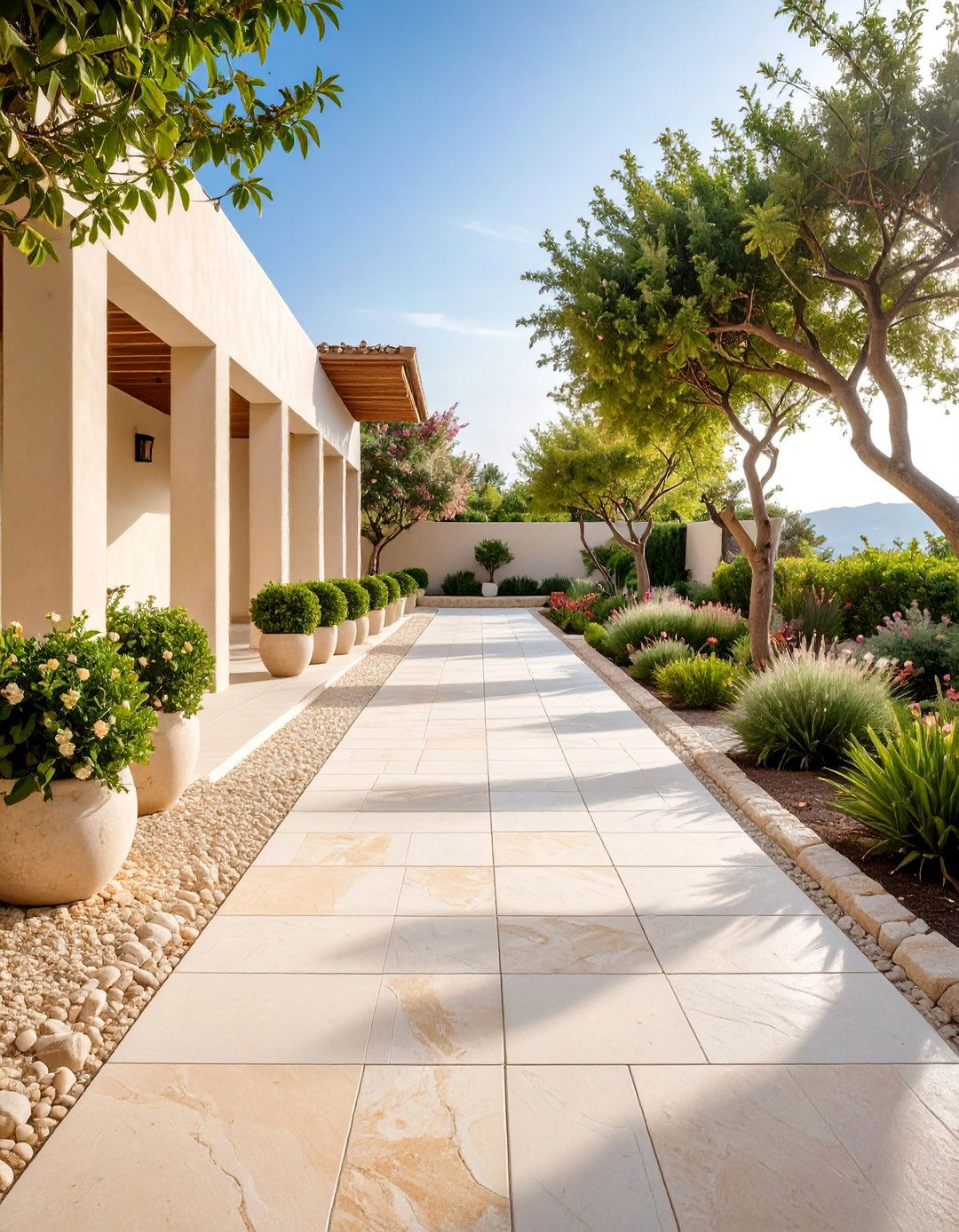

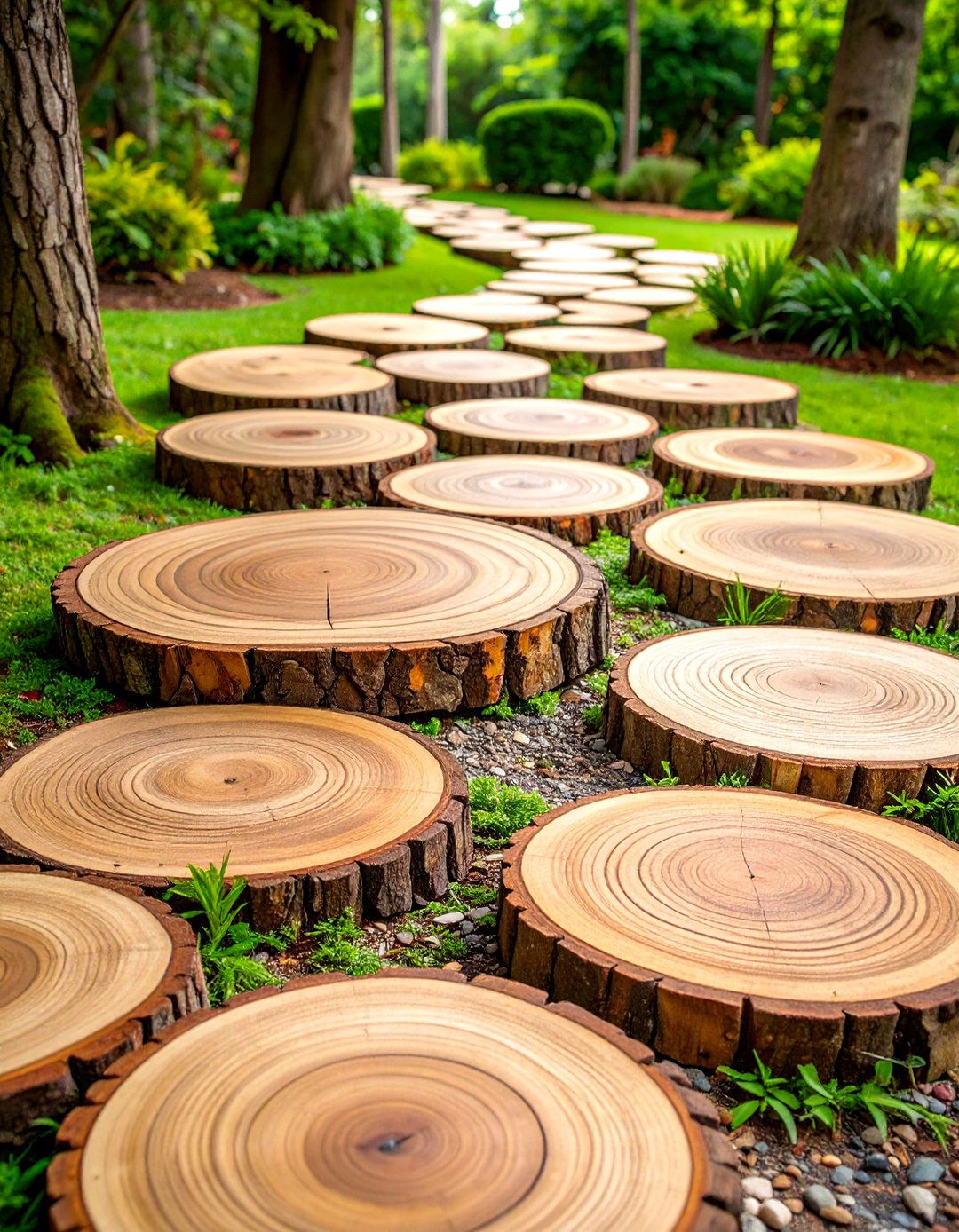


Leave a Reply